TOOLKIT ON GENDER INCLUSIVE POLICY DEVELOPMENT

TOOLKIT
ACKNOWLEDGMENTS
This toolkit is a product of AFI’s Gender Inclusive Finance workstream.
Contributors: From the AFI Network: Aishath Asna Hamdi (Maldives Monetary Authority), Ann Valery Victor (Banque de la République d’Haiti), Arlindo Francisco Lombe (Banco de Moçambique), Brenda Mwanza (Bank of Zambia), Catalina Pazos (Superintendente de Economía Popular y Solidaria, Ecuador), Christian Tondo (Central Bank of Paraguay), Christine Toussaint (Banque de la République d’Haiti), DABOU Niffone Jacqueline (Banque Centrale des Estats de l’Afrique de Ouest), Diane Jocelyn Bizimana (Banque de la République du Burundi), Dr. Settor Amediku (Bank of Ghana), Esperança Costa (Banco Central de São Tomé e Príncipe), Fatou Deen Touray (Central Bank of the Gambia), Fonsia Mohammed Donzo (Central Bank of Liberia), George Awap (Bank of Papua New Guinea), Ibtissam El Anzaoui (Bank Al-Maghrib), Jenny Romero Asistin (Bangko Sentral ng Pilipinas), Joseph Esala Masitabua (Reserve Bank of Fiji), Lanna Lome-Ieremia (Central Bank of Samoa), Ligia Marcela Herrera (Comisión Nacional de Bancos y Seguros, Honduras), Linda Folia (Central Bank of Solomon Islands), Mary Anderson (First Atlantic Bank), Mir Ahmad Shekib Mir (Da Afghanistan Bank), Mohamed Lamine CONTE (Banque Centrale De La Republique De Guinee), Mohannd Salou (Palestine Monetary Authority), Nadezhda Prasolova (Bank of Russia), Nadia Alloh (Central Bank of Jordan), Nadimo Carimo (Banco de Moçambique), Nathalie Lamothe (Banque de la République d’Haiti), Nivoarizay Liva Razafindrakoto (Direction Générale du Trésor/Ministère de l'Economie et des Finances, Madagascar)
Pemadorji (Royal Monetary Authority of Bhutan), Rakotoarimanana Hery Njaka (Ministère des Finances, Madagascar), Rose ObengDokyi (Bank of Ghana), Saja Farhan (Central Bank of Jordan), Samuel Quansah (Zenith Bank (Ghana) Limited), Shakhnozakhon Mukhamadieva (National Bank of Tajikistan), Suame Tehia Felix (Ministère de l'Economie et des Finances de Côte d’Ivoire), and Teresa Evaristo Pascoal (Banco Nacional de Angola).
From the AFI Management Unit: Audrey Hove (Policy Specialist), Beryl Tan Yi Lu (Senior Program Analyst), Eliki Boletawa (Director, Policy Programs and Implementation), and Helen Walbey (Head, Gender Inclusive Finance).
We would like to extend a special thanks to FinValue Advisors (consultants) for their contributions to this toolkit.
Special thanks to all member institutions that participated in the survey and focus group discussions to inform this note.
We would like to thank AFI member institutions, partners, and donors for generously contributing to the development of this publication.
The Gender Inclusive Finance workstream is partially financed by Sweden and other partners.
2 TOOLKIT ON GENDER INCLUSIVE POLICY DEVELOPMENT INTRODUCTION 3 PRE-FORMULATION PHASE 5 FORMULATION PHASE 17 IMPLEMENTATION & MEASUREMENT PHASE 20 CONSIDERATIONS FOR AFI POLICY AREAS 24 ADDITIONAL CONSIDERATIONS AND WAY FORWARD 34 ABBREVIATIONS 36 REFERENCES 36 CASE STUDY SOURCES 37 RESOURCES FOR FURTHER CONSIDERATION 37 ANNEXES 38 © 2022 (December), Alliance for Financial Inclusion. All rights reserved. CONTENTS
Asian businesswoman running a workshop. (FangXiaNuo/iStock)
INTRODUCTION
WHAT IS THE GENDER INCLUSIVE FINANCE TOOLKIT?
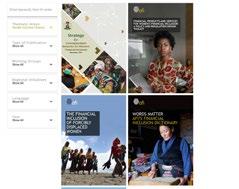

Members of the AFI network endorsed the Denarau Action Plan in 2016 and have committed to reducing the gender gap in financial inclusion. The Denarau Action Plan identifies measures AFI members can take to increase the number of women with access to quality and affordable financial services globally.
This toolkit supports AFI members and the AFI Management Unit in their work on financial inclusion policy by providing practical guidance to AFI members and other financial inclusion policymakers seeking to integrate gender inclusive finance (GIF) considerations into the formulation and implementation of financial inclusion policy.

The objective of this toolkit is to help members of the AFI network develop a common understanding of relevant gender concepts and provide practical guidance on designing gender inclusive policy interventions for each of the seven policy thematic areas in which AFI specializes to increase the level of access and usage of formal financial services by women in their jurisdictions. Members of the AFI network report a desire and commitment to integrate gender into their policy work further but lack the capacity to do so. This toolkit draws on AFI members’ input, and good global practices gathered through surveys and focus group discussions with AFI members and staff.
1/3
About a third of members have specific interventions to increase women’s financial inclusion, but only 19 percent have reviewed existing policies and regulations through a gender lens.
38%
Denarau Action Plan.
> View here
Among AFI members, the biggest obstacles to integrating GIF considerations into their policies are a lack of sufficient resources (38 percent) and a lack of effective processes to integrate GIF into their work (33 percent).
The toolkit contains mini-case study examples from across the AFI network. Many are thoroughly covered in the gender AFI publications library.
Many are thoroughly covered in the gender AFI publications library.
> View here
Members are encouraged to connect and share learning experiences and policy guidance. A list of publications and other relevant resources can be found at the end of the toolkit for further reading.
3 TOOLKIT ON GENDER INCLUSIVE POLICY DEVELOPMENT
STRUCTURE OF THE GENDER INCLUSIVE FINANCE TOOLKIT
This toolkit manual complements the GIF slide deck and provides practical guidance for incorporating each recommended element. The toolkit manual is structured around the three policy development phases (Figure 1) below:
> pre-formulation,
> formulation, and
> implementation and measurement.
The recommended steps are outlined under each of the three phases. This also includes a checklist of questions to be answered as an outcome of the work under that step. This is followed by the recommendations on integrating gender across the seven AFI policy areas.
Phase 1: pre-formulation entails gathering information on the existing policies, stakeholders, and activities that can influence GIF. It is also useful to establish what data indicators are held and by whom. At this stage, it is critical to establish appropriate coordination structures and mechanisms (potentially including both internal and external stakeholders) to ensure the gender agenda is driven through the policy formulation and implementation process.
Once the structures and mechanisms are in place, conduct a diagnostic to establish a baseline of the current financial inclusion landscape and gain insight into the challenges men and women face in accessing and using financial services that can be addressed through policy or regulatory action.
FIGURE 1: THE THREE POLICY DEVELOPMENT PHASES PHASE 1 PRE-FORMULATION PHASE 2 FORMULATION
> Establish coordinating structures
> Undertake gender-sensitive capacity-building
> Take stock of the existing policies and carry out diagnostic studies through a gender lens
> Conceptualize a GIF agenda within a national strategy/ framework
> Identify priorities and set sex- and age-disaggregated targets based on relevant baseline data
> Develop a SMART gender action plan based on sex-disaggregated data
> Identify and engage with stakeholders
PHASE 3 IMPLEMENTATION AND MEASUREMENT
> Develop a gender-sensitive M&E framework
> Conduct gender-sensitive evaluation
4 TOOLKIT ON GENDER INCLUSIVE POLICY DEVELOPMENT
At this stage, the outputs include
> a concept note outlining the scope of the proposed project, objectives, timelines, and milestones of any proposed activities (see Annex 1 for a sample)
> a diagnostic assessment questionnaire and assessment results.
In Phase 2: the formulation, the institution should define the vision, goals, and targets. If not already done during the pre-formulation phase, it is useful to reach out to the public and private sector stakeholders for their input and perspectives and to share information regarding the diagnostic assessment. A clear strategic vision and gender-sensitive targets should be established based on prioritizing the challenges uncovered by the diagnostic assessment.
In this phase, the primary outputs include
> a monitoring and evaluation (M&E) framework that details how the proposed activities will lead to the intended outputs and contribute to the outcomes driving greater women’s financial inclusion and closing the gender gap in financial inclusion.
Finally, Phase 3: implementation and measurement, calls for the gender strategy to be put into action. The GIF activities should be tracked through a gender action plan (GAP) and/or log frame throughout this phase. Progress should be monitored and measured through a gender-sensitive M&E framework with gender-specific indicators. Sex- and age-disaggregated data should be collected and analyzed to allow for differential analysis of the impact of the activities on the target groups, including women, men, youth, and others.
PREFORMULATION PHASE
In this phase, the main objective is to build the knowledge and establish the structures necessary to ensure the institution is prepared to integrate GIF considerations across all interventions throughout the policy lifecycle. These include strengthening gender awareness through appropriate capacity-building at multiple levels of the institution, establishing coordinating structures, and conducting a stocktake of existing financial inclusion policies, regulations, and activities.
There are seven steps which include etablishing the baseline for gender awareness in the institution, building the capacity of people on gender inclusive financial and institutional topics, activate appropriate coordinating structures, undertake gender focused stock-taking and diagnostic studies, set priorities and define appropriate targets, develop a gender action plan, and lastly implement gender sensitive monitoring and evaluation methods.
STEP 1: ESTABLISH THE BASELINE FOR GENDER AWARENESS IN THE INSTITUTION
Understanding the level of awareness and knowledge about women’s financial inclusion across the institution is vital. Ideally, timely and relevant data will assist because it can measure attitudes and perceptions and help understand key terms related to women’s financial inclusion and gender equality. Surveys and focus groups are good instruments to use as a starting point for gathering internal data.
STEP 2: GENDER CAPACITY-BUILDING
After the baseline has been established and the knowledge gaps have been identified, it is important that all staff at the policy development and implementation levels receive some training on the need for and institutional benefits of gender mainstreaming, as well as how to incorporate gender considerations into their work.
5 TOOLKIT ON GENDER INCLUSIVE POLICY DEVELOPMENT
Ensuring all staff members have equal access to training opportunities is critical. An institutional self-audit, such as the ILO’s Participatory Gender Audit,1 can help the institution review its internal resources, processes, systems, and practices to develop targeted capacitybuilding programs.
Capacity-building programs should focus on integrating gender considerations into policy and communication. They should also strengthen gender capacity at an institutional level to ensure the sustainability of changes. Training should be as relevant to the work of the staff as possible. All staff should understand the following key aspects:
> key gender concepts and terminologies used in the financial inclusion landscape
> identify gender inequalities in their field of activity
> define financial inclusion objectives and the broader goals related to women’s economic empowerment and gender equality
> integrate a gender lens when planning and implementing policies
> monitor progress through a gender lens
> evaluate programs and policies from a gender perspective
> communicate any gender-focused policy activities to the communications department for internal and external communication activities.
CASE STUDY 1: ZAMBIA
The Bank of Zambia has a gender expert who conducts sensitization training for the staff and offers gender equality training that is provided by the Turin Centre, Italy.
The goal of the training is to raise awareness and help both men and women understand that gender diversity is not about getting rid of men but about making sure that both men and women are fairly represented in the workplace.
The institution should consider building a business case for gender diversity and a gender-balanced decisionmaking environment.
The objective of such initiatives is not just about increasing the proportion of women employed. Rather, it is about developing a pipeline of qualified women and creating an enabling environment for women to move into leadership positions, so there is better balance across the institution from top to bottom. Evidence suggests that higher levels of gender diversity improve the performance of organizations, including financial institutions. In fact, studies have shown that higher participation by women in monetary policy decisions is associated with better performance in terms of inflation.3
A commitment to gender mainstreaming and accountability should be built into any capacity-building initiative. Three essential elements include:
> Explicit mandate: the institution should make an official statement on gender mainstreaming that defines the overall vision for mainstreaming gender in the institution.
> Dedicated leadership: it is critical to have an unequivocal and visible commitment from the highest levels of management because it demonstrates buy-in and support and sets an example for staff to strengthen the position of the gender focal point/working group/mainstreaming unit and GAPs.
> Clear assignment of responsibilities: internal transparency and a clear delineation of responsibilities encourage accountability in the institution.
It is also important to remember that resistance to change is often part of the process. Overcoming resistance can be challenging. Lack of knowledge, understanding, and fear of change may manifest as resistance. Capacity-building efforts should involve staff at all levels in identifying resistance points and potential solutions, which also helps build ownership of the solutions.
While gender training should be centered on supporting staff to mainstream gender in their functional areas, it is important to remember that gender training is not just about skills but also about shifting attitudes. To accomplish this, it is recommended that training follow a participatory methodology, similar to the GALS learning system,2 that encourages reflection on immediate work and the broader gender environment.
1 ILO. 2012. A manual for gender audit facilitators: The ILO participatory gender audit methodology (2nd Edition).
2 Oxfam. 2014. Novib Women Empowerment Mainstreaming and Networking (WEMAN). Gender Action Learning System: Practical Guide for Transforming Gender and Unequal Power Relations in Value Chains.
3 Masciandaro, et al. 2016. Gender Diversity and Monetary Policy. SUERF Policy Note Issue No 4, February 2016.
6 TOOLKIT ON GENDER INCLUSIVE POLICY DEVELOPMENT
Source: AFI Member interview. Bank of Zambia, 2021
GENDER CAPACITY-BUILDING CHECKLIST
✓ Did the institution conduct a baseline assessment of gender competences/attitudes and perceptions? Is there a common understanding of gender issues and gender mainstreaming among staff to serve as a basis for dialogue and performance indicators?
✓ Is there a common understanding of the tasks and activities necessary to carry out gender mainstreaming?
✓ Is there commitment and buy-in among staff to undertaking gender mainstreaming initiatives?
✓ Is there resistance to gender mainstreaming and what strategies and mechanisms does the institution have to combat resistance?
STEP 3: APPROPRIATE COORDINATING STRUCTURES
During the pre-formulation phase, it is important to establish appropriate coordinating structures to lead the process. Effective implementation of any initiative requires robust coordination mechanisms. Developing a new coordination structure can be a positive demonstration of buy-in and commitment, which will set the wheels in motion to mobilize efforts for the journey ahead.
A number of approaches can be taken, depending on the resources available to the institution. This is still a new area for many AFI members to explore. AFI has recognized the efforts of a number of member institutions through the appointment of GIF Ambassador Institutions.4
The member survey indicated that 29 percent of member institutions had established institutional gender focal points, and 19 percent had established a gender committee or gender working group. The approach is gaining traction across the network.
APPOINT A GENDER FOCAL POINT
Ideally, the appointment should be made by the head of the institution to a person who is senior enough to act as a catalyst in the institution. Their role needs to be communicated across the institution and given
a clear mandate. They will act as the catalyst to raise awareness and support the mainstreaming of relevant gender activities into policy and regulatory development and implementation, institutional diversity, and building a pipeline for women’s leadership. AFI member experience and industry best practices show that designating a focal point person(s) is key to maintaining momentum toward effective financial inclusion.
DEMOCRATIC REPUBLIC OF CONGO: APPOINTMENT OF GENDER FOCAL POINTS AT MINISTERIAL LEVEL
The Ministry of Gender, Family, and Children is the Democratic Republic Congo's national machinery for gender mainstreaming. A gender focal point is chosen in each line ministry. The government of each province has a minister responsible for gender-related issues and a gender division as part of its administration.
Good practice indicates that the gender focal point will not have enough influence to implement real change without a firm commitment and support from the top of the institution. If this appointment goes ahead but proves ineffective, it can do more harm than taking no action at all. It is vital to get the scope of the role and the appointment of the key person right. Gender focal points do not necessarily need to be gender technical specialists. In fact, it is recommended that a gender focal point be appointed from the senior level within the institution, as s/he will already possess intimate knowledge of the institutional hierarchies and processes. Individuals appointed to this position may have some experience promoting GIF or may be new to this work but express an interest in the objective. If the gender focal point has not worked with gender mainstreaming, they should be provided with opportunities for training and capacity-building.
4 An example of the gender ambassador model can be found in AFI’s GIF Ambassadors program, which prioritizes the gender financial inclusion agenda, takes steps to support gender equality and institutional diversity, acts as a national, regional, and global ambassador for AFI’s GIF workstream, supports the delivery of the Denarau Action Plan, and provides thorough gender leadership through global advocacy. AFI. 2019. AFI hails first Gender Ambassadors for supporting diversity.
7 TOOLKIT ON GENDER INCLUSIVE POLICY DEVELOPMENT
29%
Source: Japan International Cooperation Agency. 2017. Country Gender Profile Democratic Republic of the Congo Final Report.
APPOINT A TECHNICAL WORKING GROUP
A technical working group can be established with participants from the institution and potentially key external stakeholders to support the gender focal point and expand its reach. The working group has the responsibility to coordinate the development of appropriate policy approaches, coordinate the implementation of any gender mainstreaming strategy, raise awareness of GIF, advocate for the promotion of activities geared toward improving the institutions' diversity and women’s leadership pipeline, and monitor the process of organizational change.
The working group members can aid colleagues and leadership in building their capacity and knowledge in the subject area and cascade their learnings into their departments and teams. This will help everyone integrate gender-inclusive opportunities into their areas of work. Dissemination of information and capacitybuilding through training and seminars are also part of the work of the gender focal point and working group. When looking at the potential composition of the working group, it is important to select a diverse group of people with the knowledge, skills, and competencies needed. If the working group members have not worked with gender mainstreaming before, they should be provided with opportunities for training and capacitybuilding. Establishing clear terms of reference for the working group with clear roles and responsibilities is key to getting the right people in the group. Figure 2 shows the two forms that the working group can take.
FIGURE 2. TYPES OF TECHNICAL WORKING GROUPS
INTERNAL
> Integrated into the institution's internal procedures and hierarchies. Should have a direct link to the Governor/DG as well as specialists.
> Composition should include staff at different levels with a commitment to the gender agenda.
EXTERNAL
> External groups act in an advisory capacity.
> Bring in different expertise (officials from other relevant ministries, such as Gender Ministries and other national bodies, financial institutions, civil society organizations, etc.)
> Should be senior level officials to ensure decisions can be taken.
ESTABLISH A GENDER MAINSTREAMING UNIT
This will be a full-time unit staffed with one or more team members working on the twin aspects of mainstreaming gender considerations into policy and regulatory development. On the one hand, it will be in charge of implementation, data collection and analysis, and gender budgeting. On the other, it will support the internal activities of the institution with diversity and inclusion, and develop pipeline for women’s leadership. If the unit were just to focus on diversity and inclusion, it could be positioned in the Human Resources Department. However, due to its twin focus on policy and regulation, it needs to be supported by technical regulatory and policy expertise. Appointments to this position may be made from within or outside the institution. Ideally, the appointed persons should possess a triangulated set of competencies (Figure 1).
The technical specialists in the gender unit ideally should have these relevant qualifications:
> relevant degree in finance, economics, gender studies, or a related area
> experience in gender analysis, training, gender planning, implementation, etc.
> experience working with financial sector policy
> experience in change management
> experience with diversity and inclusion programs
> fluency in local languages
> knowledge about national policy and legislation and how it relates to gender equality mainstreaming.
STRUCTURES AND COORDINATION CHECKLIST
relevant degree in finance, economics, gender studies, or a related area
experience in gender analysis, training, gender planning, implementation, etc.
experience working with financial sector policy
experience in change management
experience with diversity and inclusion programs
fluency in local languages
knowledge about national policy and legislation and how it relates to gender equality mainstreaming.
8 TOOLKIT ON GENDER INCLUSIVE POLICY DEVELOPMENT
✓
✓
✓
✓
✓
✓
✓
FIGURE 3: COMPETENCE PROFILE FOR PERSONS IN THE GENDER MAINSTREAMING UNIT
GENDER-SPECIFIC KNOWLEDGE
POLICY-SPECIFIC KNOWLEDGE
ORGANIZATIONAL KNOWLEDGE KNOWLEDGE OF THE POLICY AREA
> sound knowledge of the organizational change process
> ability to understand the skills, needs, and areas of work of the organization
> sound understanding of the development and implementation of financial sector policy.
ORGANIZATION-SPECIFIC KNOWLEDGE
GENDER-SPECIFIC KNOWLEDGE
> sound knowledge of diversity and inclusion theories and concepts
> in-depth and up-to-date knowledge of gender issues/ theories/concepts
> appropriate knowledge of the international, national, and legal frameworks for gender equality
> knowledge and tools to mainstream gender equality.
STEP 4: GENDER-FOCUSED STOCKTAKING AND DIAGNOSTIC STUDIES
Once the coordinating structure has been established, policymakers and regulators should stocktake existing policies, regulations, and activities and apply a gender lens. This stocktaking exercise will allow policymakers and regulators to understand the current policy/ regulation environment surrounding women’s financial inclusion and identify the key issues women and men face in accessing and using financial products and services. It will enable policymakers to identify entry points for integrating GIF considerations into the proposed solutions. The institution should consider whether its current policies are gender-blind or genderaware.
If gender-aware, are they actively working toward changing gender relations (transformative) or do they reinforce current inequitable norms (exploitative)?
Gender-blind policies are based on information derived from the status quo (which generally defaults to men’s activities) and assume they will have the same impact on men and women.
Gender-sensitive policies recognize that the roles and social relationships of women and men are varied and profoundly influence their needs and aspirations.
Policies can be made gender transformative through the process outlined in Figure 2.
9 TOOLKIT ON GENDER INCLUSIVE POLICY DEVELOPMENT
CASE STUDY 2: EGYPT
The Central Bank of Egypt evaluated its policies from a gender perspective to understand where new efforts should be directed in order to develop an understanding of how to address the widening gender gap. Results revealed that while the Central Bank of Egypt has put in place a number of initiatives aimed at promoting women’s financial inclusion, significant gaps remained:
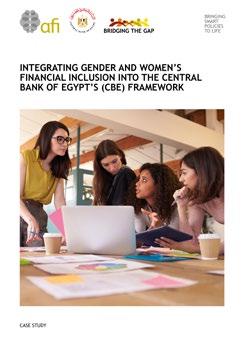
> accurate sex-disaggregated data
> expansion of digital financial services (DFS)
> encouraging electronic payments
> identify supply- and demand-side challenges
> promote financial inclusion
> encourage better coordination of financial efforts.
FIGURE 4: A GENDER TRANSFORMATIVE POLICY JOURNEY
GENDER POLICY JOURNEY
In this case study, you will learn more about the initiatives of the Central Bank of Egypt to encourage women's financial inclusion.
> View here
GENDER NEGATIVE
Creation and/ or perpetuation of barriers and challenges to gender equality.
GENDER BLIND GENDER NEUTRAL
Failure to recognize that gender as a determinant of social outcomes that result from the implementation of projects and policies.
Anything -a concept, an entity, an expression -that is not associated with a particular gender.
GENDER SENSITIVE
Ability to understand and acknowledge prevailing gender differences, issues and inequalities and to use these to design and undertake appropriate strategies and actions.
GENDER TRANSFORMATIVE
An approach that identifies the root causes of gender inequality in the field of financial inclusion, before analyzing and transforming inequitable gender norms and power dynamics into positive outcomes that directly enhance gender equity.
Policies that perpetuate challenges faced in access and usage of financial services towards certain genders.
Policies that do not consider or take into account any gender elements at all.
Policy development consider the same challenges for all genders. Patterns of access and usage of financial services perceived same for all genders.
Gender of the end beneficiary is taken into account when making policies. Initiatives taken to understand access constraints.
Policies actively remove barriers and discriminatory practices. Need for women's market development is recognized.
10 TOOLKIT ON GENDER INCLUSIVE POLICY DEVELOPMENT
GENDER-BLIND UNIVERSAL POLICY DEVELOPMENT
This policy is typically framed through the male norms and is developed, making the same assumptions for all genders, assuming they have the same challenges and opportunities.
Some assumptions may include the following:
> women and men have equal access to quality financial services and products
> women and men have equal levels of financial education and capability
> women and men have equal levels of financial resources and assets
> women and men are treated the same way by financial institutions
> the data we hold on to for men and women is the same
> women and men have equal time for productive labor and capitalizing on economic opportunities
> women and men have equal opportunities to travel to financial access points similarly.
If these are the assumptions, then the foundation of the policy needs to be revisited using a gender lens. As policymakers begin to question their assumptions and apply a gender lens to their existing policy work, they should take the time to consider how these assumptions would manifest in their jurisdictions and the unique socio-cultural context that shapes individuals' aspirations, behaviors, and experiences. It is encouraged that they involve a diverse set of stakeholders in this process, including think tanks, academics, civil society organizations (CSOs), and others, and ensure that the same set of stakeholders remains engaged and has the opportunity to provide feedback from start to finish.
GENDER LENS REVIEW OF POLICY
A lens is applied to existing or draft policy to see if it treats everyone the same (equality) or provides people with what they need to achieve the same outcomes as others (equity).
Questions to ask during a gender lens review
> Does this policy treat everyone in the same way?
> Does it consider the power dynamics and imbalances between men and women and girls and boys?
> Does it consider the different roles, rights, and responsibilities men and women have in society and underlying implications?
> Are the policy and the wider legal frameworks structured through male norms and standards, if so, how does it need to be revised to be equitable?
> Will women be able to benefit from this policy in the same way as men?
> What work has already been done to understand the different women’s markets, and what more must be done to understand their needs?
> Is the M&E policy designed in such a way that it understands the needs and experiences of different genders?
To undertake a gender lens review, you can use a methodology that incorporates a desk review and input from a wide range of policymakers/regulators. Initially you can undertake a Desk review of existing policies. The key policies to examine include the National Financial Inclusion Strategy (NFIS) or Financial Sector Blueprint, the National Financial Education Strategy, DFS policy/strategy, and national policies for women and girls’ empowerment. You can then review any relevant sets of sex-disaggregated data, such as the World Bank’s Global Findex, FinScope, or national-level demand- or supply-side datasets, etc.
After this you can undertake key informant interviews with relevant ministries, public institutions, development partners, and CSOs. When the review is complete you can hold validation workshops which bringing together representatives from across the government and CSOs to present and validate findings on existing gender policies.
ROUTES TO TAKE FOR MORE GENDER INCLUSIVE POLICY DEVELOPMENT
Early stage - Develop gender-aware policy Questions to ask
> Do I know the needs and experiences of men and women at the different stages of their lifecycles?
> Do I know where I can get that information? What type of data do I need to collect?
> Do I understand that there are many different subgroups within a large group of men and women who have different needs, too (a rural woman vs. an urban woman)?
> Can I identify how the policy can meet their different needs, and have I structured it effectively and efficiently to do it?
11 TOOLKIT ON GENDER INCLUSIVE POLICY DEVELOPMENT
Mid-stage - Develop a gender-sensitive policy
Questions to ask
> Have I been able to use evidence to understand how to meet the differing needs of the various men’s and women’s groups?
> Have I developed appropriate and evidence-driven targets to help overcome some of these barriers in my sphere of influence?
> Does my policy work with gendered norms and look to address them?
> Have I been able to develop an M&E framework that considers the additional barriers most women face in society, and that considers these?
Late stage – Develop a gender-transformative policy Questions to ask
> Am I actively gathering and using disaggregated data and gender analysis to understand the underlying structures and barriers that need to be dismantled to deliver equitable outcomes?
> Am I using policy to transform the experience of women and deliver them what they need in the best way for them to engage with it (simplified access and know-your-customer (KYC) requirements, access points in places close to women, and financial education in modalities and languages that women can access)?
> Have I actively engaged with stakeholders to ensure they are working towards overcoming structural gender barriers outside of my direct sphere of influence?
> Do these stakeholders understand the segmentation of the women’s market and the market opportunities it presents?
> Is the relevant infrastructure in place to support women-owned micro, small, and medium enterprises (WMSMEs) access to credit and actively work towards closing the gender credit gap?
> What steps are being taken to put the necessary infrastructure in place, and which aspects are the highest priority for women?
> Have I put the resources in place to deliver, and what is being done to build capacity in the whole ecosystem?
The outcome will be a policy that works towards delivering gender-equitable outcomes for all women, regardless of their status, background, age, race, religion, ethnicity, culture, or class.
CASE STUDY 3: TANZANIA
Tanzania’s National Financial Inclusion Framework 2014-2016 prioritized the expansion of financial services to “poor rural households and their enterprises, as well as low-income women and youth.” However, the framework did not contain any gender targets or gender-specific initiatives. A review found that while important gains had been made, there was a need for a greater focus on neglected sectors, including women’s financial inclusion. Accordingly, the current National Financial Inclusion Framework 20182022 includes an explicit focus on “providing financial education and financial literacy programs for women, ensuring that all FSPs submit gender-disaggregated data for analysis, and integrate gender into policies and other related strategies.”
Source: Tanzania National Council for Financial Inclusion, National Financial Inclusion Framework (2014 – 2016) and the National Financial Inclusion Framework 2018 - 2022
National Financial Inclusion Framework 2018-2022.
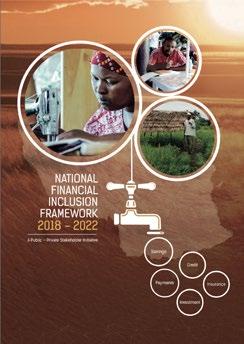
> View here
If new policies or actions need to be taken, the next recommended step is to develop the concept paper. The drafting of the concept note should be led by the technical team, with the direct involvement of the head of the institution. The gender ambassador and/ or working group should be responsible for reviewing the concept paper to ensure that gender considerations have been taken into account. This concept should begin with a problem analysis backed by data to identify ways to solve the problems within your mandate. The note should include the rationale for how the proposed activities will contribute to increasing access to and usage of financial services.
12 TOOLKIT ON GENDER INCLUSIVE POLICY DEVELOPMENT
The concept paper should also highlight the current data availability and potential data needs to ensure indicators are collected, and targets can be established. It is also important to identify any potential risks and develop mitigation strategies to manage those risks. At this stage, it is also recommended that the institution explain any technical, human, and financial resources required to integrate GIF to ensure that a lack of resources does not impede progress.
Gender-sensitive diagnostic studies should be conducted to understand the current levels of financial inclusion, assess gender gaps in access and usage, and allow for the setting of realistic objectives. This can be undertaken in parallel with the policy stocking exercise. It is critical to include an analysis of sex-disaggregated data to establish any gender differences in the diagnostic study.
GENDER STOCKTAKING CHECKLIST
✓ What policies already exist or are planned? Are these policies gender-neutral, genderblind, or gender-sensitive?
✓ Are any existing policies with an explicit gender dimension (gender relations, values, norms, beliefs, and attitudes are considered during the policymaking process)?
✓ Do the policies and strategic objectives show that gender is understood as concerning women or men only or both sexes and the relations between them?
✓ Is promoting gender equality, women’s economic empowerment, or women’s access to finance identified as a high-level policy goal?
✓ Is there a high-level commitment to gender equality/women’s economic empowerment in the country?
✓ Are women's “invisible” and/or non-market activities (unpaid care work, unpaid work in the family business, activities in the informal sector, etc.) part of the data collection, analysis, and recommendations throughout?
✓ Are there any gaps that can be addressed through policy reform? Can targets (and/or timelines) be introduced into policies where no targets previously existed?
48%
Almost half of the AFI member countries surveyed in the AFI member survey collected sexdisaggregated data on the supplyside (48 percent) and the demandside (43 percent).
If no sex-disaggregated data is available, surveys and other forms of sex-disaggregated data collection can be commissioned to support diagnostic work. Diagnostic studies should apply a multi-level diagnostic approach that explores structural parameters and market dynamics through a gender lens to understand how gender-related socio-economic, political, and cultural factors play out in the financial markets (Figure 3).
FIGURE 5: MULTI-LEVEL DIAGNOSTIC APPROACH
Market structure: An assessment of the key drivers of the demand and supply of finance for women and women-owned businesses should be made to determine how to serve the female market better.
13 TOOLKIT ON GENDER INCLUSIVE POLICY DEVELOPMENT
GENDER ISSUES OPERATIONAL DYNAMICS FOR SERVICE PROVIDERS BUSINESS ENABLING ENVIRONMENT MARKET STRUCTURE
CASE STUDY 4: SOLOMON ISLANDS
The Solomon Islands conducted a Financial Service Demand Side Survey in 2015, which collected information on financial inclusion access strand, financial literacy, distance to banks, etc. Results revealed that only 20 percent of women have bank accounts, compared to 32 percent of men. The Central Bank has used this information to develop a target of 150,000 new women financial users (half of the total target of 300,000).
A partial answer can be found through data mining of previous datasets (AFI data portal,5 FinScope, FinAccess, Global Findex) or collecting primary demand-side data.6 Potential methodologies for collecting demand-side data are outlined in AFI’s Guideline Note 10 on Financial Inclusion Data Tracking and Measurement, Demand-Side Surveys to Inform Policymaking. An overview of the various methodologies is outlined below.
> Household and enterprise surveys: These are aimed at providing quantitative and representative data on financial usage among the population.
> Financial diaries: These are surveys of households taken at regular intervals over time, which provide insights into financial management and financial flows.
Women’s Financial Inclusion in the Solomon Islands a Simple Opportunity can Make a Difference.
> View here
The first step in this approach will be to determine what types of financial services women are currently using and what their current and future needs are regarding financial and non-financial services. The types of products and services available and used by women and trends in the supply of finance can be gathered through structured interviews with financial service providers (FSPs), researchers, and women.
Using available sex-disaggregated data, the institution can achieve granularity in the data to identify the specific subgroups of women that are more vulnerable and whose financial needs are not satisfied or partially satisfied (MSMEs, rural, smallholders, etc.). Key research questions to be answered include:
> What is the profile of urban/rural women and women-owned and led MSMEs and/or SMEs?
> How do women and men access and use financial services?
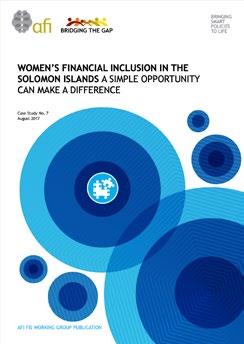
> What is the current access, usage, and quality level among different segments?
> What are the main barriers to accessing and using finance among the different segments?
> What financial and non-financial products and services would help women and other vulnerable groups address their needs?
> Focus group discussions: These qualitative methodologiesy providing provide an in-depth of understanding about of issues, such as attitudes towards particular financial products or financial institutions, or why people make certain financial choices.
> Financial services-based surveys: These consist of targeted surveys, such as mystery shopping and exit interviews among those currently accessing financial services.
An assessment should also be made of key policy, regulatory, and socio-cultural factors that typically inhibit or facilitate women’s access to financial services.
The first step will be to review the existing legal framework and understand potential gaps or barriers embedded in local laws, quasi-legal norms, and legal practices. In addition to official regulations and policies, it is important to examine socio-cultural norms and beliefs, how these shape gender identity and behavior, and the perceptions that guide how men and women interpret and experience aspects of their lives differently. The institution should critically examine how gender affects how people are treated and regarded by customary law, the formal code, and the judiciary system. It is important to consider the different roles of women, including as regulators, in the financial industry, as business owners and employees, in community decision-making, and the household.
5 AFI. AFI data portal.
6 AFI. 2013. Financial Inclusion Data Tracking and Measurement. DemandSide Surveys to Inform Policymaking.
14 TOOLKIT ON GENDER INCLUSIVE POLICY DEVELOPMENT
Source: AFI WOMEN’S FINANCIAL INCLUSION IN THE SOLOMON ISLANDS - A SIMPLE OPPORTUNITY CAN MAKE A DIFFERENCE - Case Study No. 7 August 2017
Legal rights, including inheritance, legal documents, reproductive choice, representation, and due process, can significantly impact the power that men and women possess. For example, in some countries, a woman must get permission from a male relative to open a bank account or make financial spending decisions. The ability of women to access finance can also be restricted by laws and policies that restrict women’s power over other types of assets.
> What are the formal laws and regulations regarding who may own property and enjoy full property rights? Are these laws gender-neutral, or are women discriminated against?
> What laws are there governing what can be used as collateral?
> What is the experience of financial sector institutions in terms of regulatory constraints/ opportunities for disbursing finance? Is it the same for men and women?
> What policies govern business registration, and are they gender-neutral?
> What policies are in place to improve women’s access to finance, particularly for women-owned businesses?
CASE STUDY 5: ZIMBABWE
As part of its NFIS implementation, the Reserve Bank of Zimbabwe conducted a stakeholder mapping to understand the major players in the gender ecosystem. Women’s empowerment organizations included the Ministry of Women Affairs, Gender and Community Development, New Faces, New Voices – Zimbabwe Chapter, UN-Women, Zimbabwe Women Resource Centre, Women’s Alliance of Business Associations in Zimbabwe, African Women’s Initiative in Developing Economies, and the Self-Help Development Foundation.
These organizations were engaged to support the implementation of the strategy through participation in working groups.
Source: AFI member interview, Reserve Bank of Zimbabwe, 2021.
Under this dimension, institutions would seek to assess the availability of adequate financial products. In this context, it is important to carry out a gendersensitive mapping of service providers to link the types of suppliers to their respective targeted clientele. A comparative analysis can then be conducted of the finance offerings, strategy, pricing, and targeted clientele by categories of FSPs, focusing on the relevant financial products, terms, and market segments. International supply-side data sources can be helpful here, such as the International Monetary Fund’s Financial Access Survey and MIX Market, as well as data collected directly from FSPs. Collecting nationallevel sex-disaggregated supply-side operational data is critical to understanding the situation of men and women in financial inclusion.7
> Are there FSPs, that target women as clients?
> How effective and efficient are FSPs at serving women clients?
> What current FSPs market positioning, product offering, etc., caters to women clients?
> What are the structural dynamics within the sector and key trends?
> What is the current vs. potential contribution of FSPs to greater financial inclusion?
> What strengths/vulnerabilities have the potential to impact the future of the sector?
> What constraints and challenges do financial institutions face in offering financial products and services to women clients?
> What major risk factors FSPs need to overcome to target larger numbers of women clients?
Guideline Note on Sex-Disaggregated
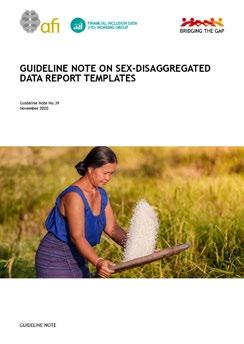
Data Report Templates.
> View here
Operational dynamics for service providers: An assessment should be made of key operational factors affecting the ability of credit institutions to offer adequate finance products to women and women MSME. 7 AFI. 2020. Guideline Note on Sex-Disaggregated Data Report Templates.
15 TOOLKIT ON GENDER INCLUSIVE POLICY DEVELOPMENT
CASE STUDY 6: BURUNDI
The Banque de la République du Burundi (BRB) requests data from financial institutions disaggregated by a commune (geographical unit), sex, and age, wherever possible. In order to make sure that all the supervised financial institutions provide the requested information on time, the Central Bank developed a comprehensive supply-side questionnaire framework. It has been on the BRB’s website since early 2019.
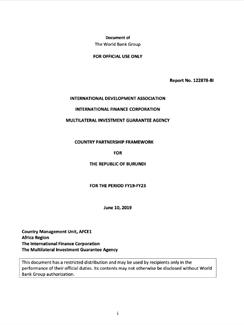
Every institution is requested to designate two staff members responsible for completing the online questionnaire. BRB organized a number of sessions with the designated persons in order to establish a common understanding of the requirements and detail the process of how to complete the questionnaire online to make sure they get the correct information.
Finally, BRB has taken steps to remind the designated persons of their duties to complete the questionnaire at least one month before the deadline.
Source: Banque de la République du Burundi website
BRB's supply-side questionnaire framework.
> View here
DIAGNOSTIC CHECKLIST
✓ Are strategic choices based on gender, stakeholder, or market analyses?
✓
Is sex-disaggregated data (on both the demand- and supply-side) collected and used systematically in planning and reporting?
✓
✓
Are participatory methods used for assessing needs and markets?
What are the gender gaps in financial inclusion across different dimensions (access, usage, quality)?
✓
What are the major challenges to women’s financial inclusion that could potentially be addressed through targeted policy and regulation?
16 TOOLKIT ON GENDER INCLUSIVE POLICY DEVELOPMENT
FORMULATION PHASE
The formulation phase should be used to define the clear vision, goals, and targets of the proposed strategy. Key outputs of this phase should include setting specific priorities and targets to overcome these challenges. Finally, the institution should develop an M&E framework to translate objectives into activities and structure planning before implementation.
STEP 5: SETTING PRIORITIES & DEFINING TARGETS
Based on the diagnostic analysis, the institution should have a list of the identified gender gaps. In this step, a final action is to translate the GIF goals into measurable and time-bound targets that permit active management and progress. The needs of the target groups should inform how the priorities are identified. If the main goal is not specifically defined by gender (i.e., it is more general financial inclusion), the institution should think carefully about how women’s needs are different from men’s so they are not overlooked when policies are designed.
Define targets and objectives that acknowledge different levels of financial service access and usage for women and men. This process should involve coordinating with key public and private stakeholders, including women’s groups.
CASE STUDY 8: CAMBODIA
The National Bank of Cambodia has worked with other relevant ministries and agencies to formulate the NFIS 2019-2025.
The strategy aims to increase the level of formal financial inclusion from 59 percent to 70 percent and reduce women’s financial exclusion by half. These targets were set based on an examination of data from the Global Findex and local data, which found a significantly higher rate of financial exclusion among women.
Source: The Kingdom of Cambodia. National Financial Inclusion Strategy 19192025
CASE STUDY 7: FIJI
Fiji’s third NFIS (2022-2030) prioritizes vulnerable and disadvantaged segments of the population. It particularly aims to address the persistent barriers and challenges faced by women, youths, people living with disabilities, as well as MSME business owners in the financial sector.
Short-term, medium-term, and end-term targets have been set for various segments of the population, including women, youth, and people living with disabilities have been set across access, usage, and quality indicators.
In setting targets, it is critical to keep in mind that they should be specific, measurable, achievable, relevant, and time-bound (SMART).
> Specific - What is to be achieved must be very clear and straightforward.
> Measurable - What is to be achieved must be measurable, and its progress can be tracked with relevant indicators.
> Attainable - The target should be ambitious but still realistic in the country’s context.
> Relevant - What is to be achieved must be relevant in the country’s context.
> Time-bound - A time frame must be specified for what is to be achieved.
SETTING TARGETS CHECKLIST
✓
What is the vision of the planned activities for accelerating women’s financial inclusion and closing the gender gap?
✓
What do you hope to achieve through the effective implementation of this strategy, policy, or activity?
✓
How does this strategy align with the wider economic development strategy of the country? How does this strategy align with the sustainable development goals and related activities?
✓
✓
What is the overall objective of the proposed strategy?
What are the individual outcomes that should be achieved?
17 TOOLKIT ON GENDER INCLUSIVE POLICY DEVELOPMENT
Source: FIJI - National Financial Inclusion Strategy 2022-2030
STEP 6: GENDER ACTION PLAN
To lay the groundwork for effective policy implementation, developing a GAP that outlines the road map, priorities, and timelines for gender-related activities and/or interventions to be undertaken is recommended. The GAP should be SMART. It should also be made public to ensure broad stakeholder buy-in and improve accountability for reaching goals.
When preparing the GAP, consider whether it is necessary to create differential actions targeting women and men and gender-specific sub-segments in line with any overarching strategic sex-disaggregated objectives and targets.
CASE STUDY 9: ESWATINI
The Kingdom of Eswatini’s Ministry of Finance is a recipient of AFI’s in-country support to develop a GIF roadmap. The roadmap aims to enhance the financial inclusion of women and guide financial institutions to design financial products and services that meet their needs.
The following specific elements should be included in the GAP:
> Who is responsible for each activity?
> Who is responsible for monitoring progress?
> What resources are needed to carry out the activity?
> What is the expected date of completion of the activity?
> How will progress be monitored and evaluated (by whom, when, and how)?
Preparing a communications strategy should also be a part of the GAP. AFI Toolkit Communicating Women’s Financial Inclusion can help guide communications during the official launch of any proposed policies to close the gender gap. It is recommended to coordinate all communications efforts with other government ministries and gender issues-focused CSOs.
These stakeholders are vested in closing the gender gap in financial inclusion. They can be an important source of collaboration, ensuring the success of the proposed activities because they also contribute to their broader objectives.
FIGURE 6: GENDER AWARENESS-RAISING MEASURES
Large scale communication initiatives (television, newspapers, radio, websites)
Public events (concerts, festivals, etc.) that target specific groups
Social media and social networks
Community-based initiatives (public meetings, presentations, workshops, informal social events)
Print materials (brochures, billboards, cartoons, posters)
18 TOOLKIT ON GENDER INCLUSIVE POLICY DEVELOPMENT
Source: AFI Gender Inclusive Finance Unit interview, 2021
1 2 3 4 5
CASE STUDY 10: CAMBODIA
The National Bank of Cambodia’s NFIS 2019-2025 stipulates many actions including: developing a pipeline of current and future women leaders, collecting and analyzing sex-disaggregated data, integrating financial literacy into the general school curriculum, enhancing financial literacy among women entrepreneurs, and encouraging the use of DFS. The National Bank of Cambodia is working with the Ministry of Women’s Affairs to prepare a women’s financial empowerment program.
Source: The Kingdom of Cambodia. 2019. National Financial Inclusion Strategy 2019-2025.
Good communications strategies will combine different channels to reach targeted audiences in local languages. AFI’s toolkit on Communicating Women’s Financial Inclusion can be utilized by the institution in developing an appropriate strategy.
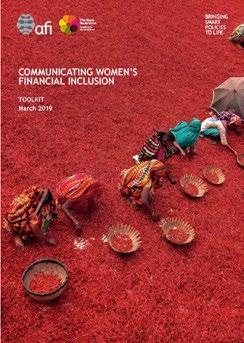
GENDER ACTION PLAN CHECKLIST
✓ Have you developed a gender equality action plan incorporated into an annual plan for the work unit and staff members’ annual work plans through consultation with a range of staff? Are these plans discussed and disseminated?
✓ What are the modalities for implementing technical cooperation projects: explicit integration of gender equality, separate programs, separate project components, separate budget allocations for women and gender mainstreaming?
✓ Do you have staff members dedicated to communications and advocacy? If yes, are they trained in gender-sensitive communications and able to integrate gender equality into communication strategies?
✓ Do your communication strategies include specific provisions for the elimination of bias and stereotypes that support gender discrimination?
✓ Is the information on gender equality available in all national languages?
Communicating Women’s Financial Inclusion.
> View here
> Include a balanced number of women, men, girls, and boys.
> Show diversity - gender, age, ethnicity, (dis) ability, roles, religions, rural/urban, etc.
> Use gender-inclusive language delivered in a way that is easy to understand.
> Include women, men, girls, and boys in comparable and diverse roles. E > Show women, men, girls, and boys in nonstereotypical roles.GE
> Be specific – show numbers where possible.
> Provide sex- and age-disaggregated information.
19 TOOLKIT ON GENDER INCLUSIVE POLICY DEVELOPMENT
FIGURE 7: TIPS FOR GENDER-SENSITIVE COMMUNICATIONS SHOW DIVERSE PERSPECTIVES USE GENDERINCLUSIVE LANGUAGE CHALLENGE THE NORMS PROVIDE DATA
> Communicate in languages that are easily understood by the majority. THE NORMS
IMPLEMENTATION AND MEASUREMENT PHASE
The main objective of this phase is to implement the activities necessary to put the gender strategy into action. Key steps include developing and implementing a GAP, gender-responsive budgeting, and gender impact assessment. Activities should be tracked, and progress evaluated and measured according to the M&E plan throughout this phase.
STEP 7: MONITORING AND EVALUATION
Identifying a responsible party for monitoring the progress of the GAP is essential for effectively implementing the planned activities and initiatives. Accordingly, this entails the need to develop an M&E framework.
established in step five. In this section, this toolkit will focus on developing a results framework for the GAP. Developing a results framework will also lead to establishing preliminary lists of identified risks (and mitigation steps) and indicator profiles. These should be finalized with the results framework and will form the basis of the GAP’s M&E framework.
RESULTS FRAMEWORK
Achieving the targets outlined in the GAP should be guided by the results chains or pathways established in a theory of change.8 The strategic guidance captured in a theory of change illustrates anticipated progression that indicates how the policy interventions will lead to expected changes that drive women’s financial inclusion and close the gender gap.
A results framework provides an operationalized articulation of how the targets set out in the GAP are achieved through planned activities and initiatives that lead to substantive outputs in the form of material goods or services produced, which lead to changes in institutional/community behavior (outcomes) that are expected to contribute to societal change, i.e., the impact. The results framework outlines how to measure results, linking each outcome with the requisite activity and output, identifying relevant assumptions, and laying out key measurement indicators across output and outcome levels. The results framework should include relevant gender considerations at each stage (Figure 8).
An M&E framework for any program, strategy, initiatives, implementation plan, action plan, etc.in this context, a GAP - will entail the development of a results framework. The baselines for the results framework are established from the gender- focused stock-taking and diagnostic studies, as suggested in step four and aligned with the priority areas and targets 8 See
FIGURE 8: A RESULTS FRAMEWORK FOR GENDER INCLUSIVE FINANCE POLICY
INPUTS OUTPUTS OUTCOMES IMPACT
GENDER EQUALITY CONSIDERATIONS
> Are contributions from women and men accounted for?
> Do inputs account for women's access and control over resources?
> Is the distribution of benefits taking gender roles and regulations into account?
> Are data for verifying outputs sexdisaggregated?
> Does the strategy have gender responsive objectives?
> What measure can verify achievement of gender responsive objectives?E THE NORMS
> Do gender relations influence the intended impacts?
> Do the intended impacts influence gender relations?
20 TOOLKIT ON GENDER INCLUSIVE POLICY DEVELOPMENT
Annex 2 for AFI’s Gender Inclusive Finance Theory of Change.
TABLE 1: RESULTS FRAMEWORK
The format and the level of detail of the results framework vary according to the scale of interventions, organizational monitoring, and reporting needs, among others. A typical results framework should include the following:
INPUT The resources used to perform the GAP activities including people, money, expertise, technology, and information.
For example, one dedicated full-time equivalent to support the implementation of gender-related activities.
ACTIVITY Action taken or the work performed as part of the GAP with the mobilization of inputs, such as funds, technical assistance, and other types of resources towards specific outputs.
For example, the provision of technical assistance to assist with a gender review of select financial inclusion policy documents.
OUTPUT The products or services that result from the GAP activities or initiatives.
For example, 425 policymakers and regulators receive training on GIF.
OUTCOMES The envisioned short-term or medium-term results of the outputs achieved in the GAP. Outcomes are changes resulting from the completion of outputs. Outcome-level changes contribute to the achievement of impact-level changes.
For example, effective supervisory and enforcement mechanisms for gender-sensitive policy/ regulation are developed.
INDICATORS Qualitative or quantitative factor or variable that provides a means to demonstrate change (or achievement) of the output and outcome.
For example, the number of policymakers and regulators trained in GIF.
BASELINE A set of factors or variables that describe the situation before any intervention through the GAP, which is used as the basis to assess any change after implementation.
TARGETS The desired, expected, and measurable results expressed in terms of quantity, quality, and time.
RESULTS FRAMEWORK CHECKLIST
✓ Are gender equality objectives formulated and translated into performance indicators and targets at the program and budget level?
✓ What activities are specifically geared towards gender equality? What proportion of the total activities do they represent?
✓ How are gender equality activities expected to lead to outputs, outcomes, and impacts?
✓ How have these activities come about? Have they been identified through gender analysis, personnel in the institution, partner institutions, or by others?
✓ What resources are needed to complete the planned initiatives successfully?
The next step in the development of the policy is to align sex-disaggregated data collection and monitoring systems so that progress toward gender inclusion can be tracked efficiently and effectively. A results framework is an essential tool for ensuring strategic coherence and enhancing institutional performance, increasing the focus on results at the governance level. The M&E framework should include operational procedures and tools, such as planning tools, a data collection toolkit, evaluation/measurement tools, reporting/dissemination tools, etc. It should also include a comprehensive list of indicators relevant to gender activities and the intended data collection periods. Key elements of the M&E Framework should be:
> plan for collecting sex-disaggregated data and ensuring data quality, relevance, and timeliness
> plan for how sex-disaggregated data will be used
> plan for ensuring data and monitoring systems are adequate for collecting and tracking across gender indicators
> plan for assessing and mitigating risks in M&E.
21 TOOLKIT ON GENDER INCLUSIVE POLICY DEVELOPMENT
Source: OECD/DAC. 2002. Glossary of Key Terms in Evaluation and Results-Based Management.
CASE STUDY 11: HONDURAS
The Comisión Nacional de Bancos y Seguros (CNBS) has been publishing annual reports with sex-disaggregated information on the conditions of access and use of financial products and services. The availability of this data will encourage collaboration between the regulator, CSO, and the private sector in designing innovative solutions that respond to the unique behaviors and needs of women and men, as well as build on the progress made in accelerating women’s financial inclusion.
Since 2019, a process of data collection disaggregated by sex was put in place as a follow-up to the Financial Inclusion Plan for Women. The CNBS is currently working on a Data Reporting Manual. The objective is to serve as a reference guide for the institutions of the Supervised System to understand better the general guidelines, conditions, and procedures to create the data files that contain the information on the Financial Inclusion System, which must be sent to the CNBS.
STEP 8: GENDER-SENSITIVE EVALUATION
European Institute for Gender Equality defines a gender-sensitive evaluation as “a systematic and objective assessment of the design, planning, implementation, and results of an ongoing or completed activity, project, program, or policy from a gender perspective.”9 It helps policymakers and regulators gain an insight into why and how projects and/or programs are addressing the needs and priorities of women and men and whether the extent to which the projects and/or programs are contributing to issues of women’s financial inclusion in the pursuit of gender equality and women’s economic empowerment. Insights generated by the evaluation can be used to improve policy design and planning and guide decision-makers in making informed and evidence-driven decisions from a gender perspective. This would require a deliberate focus on analyzing issues with the understanding that women's and men's socially constructed realities can shape their immediate needs, aspirations, and behaviors and that efforts should be taken to prevent or reduce the disadvantages that either gender experiences.
MONITORING AND EVALUATION CHECKLIST
✓ What systems, methods, and/or program instructions do the work unit staff use for planning and reporting?
✓ Are there gender-specific indicators for measuring results? Are these indicators and targets to monitor gender mainstreaming incorporated into monitoring frameworks/ mechanisms systematically?
✓ Is the quality of integration of gender issues facilitated by these systems?
✓ What are the opportunities and limitations of the existing systems and instruments for mainstreaming gender equality?
✓ How can the systems be improved to incorporate better and monitor gender issues?
✓ Are management and all staff aware of their responsibilities for mainstreaming gender?
✓ Do you have guidelines requiring you to report on gender equality progress in your annual reports?
Typically, evaluation can be carried out midway through a program and/or project (mid-term evaluation) or at the end of a program and/or project (final evaluation). Depending on the duration and scope of the project, it is common to conduct both a midterm and a final evaluation by an independent evaluator with extensive experience in gender issues.
A mid-term evaluation is especially helpful for guiding future decision-making and assessing initial lessons learned. It provides the program and/or project manager, as well as relevant stakeholders, the opportunity to identify actions to:
> address issues that arise as a result of poor design and implementation
> improve resource allocation and distribution in a manner that takes into account competing needs and priorities
> scale up initiatives that have the potential to succeed.
22 TOOLKIT ON GENDER INCLUSIVE POLICY DEVELOPMENT
Source: AFI Gender Inclusive Finance Unit interview, 2021
9 European Institute for Gender Equality. Gender evaluation.
CASE STUDY 12: HONDURAS
AFI conducted a three-day mid-term review of Eswatini’s NFIS as part of its in-country implementation program. The review process included the following:
> assessment of the progress toward a set of performance indicators and targets
> identification of the potential risks that may impede successful NFIS implementation
> verification that the NFIS objectives will be met by the end of the full implementation period in December 2022 (as per a revised action plan).
The review and corresponding consultation sessions also aimed to assist Eswatini in developing actionable policy interventions to close the gender gap in financial inclusion, in line with the AFI network's commitment to the Denarau Action Plan and Eswatini’s Maya Declaration commitment to improve access to finance for women entrepreneurs.
Technical knowledge sessions were held to guide participants in critiquing their work through a gender lens and in developing a more holistic perspective on the review and future action planning.
Following the conclusion of the review, a GIF diagnostic study was carried out. As a result of this study, a roadmap to improve the quality of financial inclusion for women was developed, with implementation set to begin in the fourth quarter of 2022.
Several considerations should be taken into account when evaluating a project from a gender perspective, including:
> Disaggregation of stakeholder groups: Data should be collected in a disaggregated manner by ethnicity, age, and sex. It must be acknowledged that your stakeholders will have varying levels of understanding of gender, as well as varying roles, levels of interest, and engagement within the program or project.
> Mixed-methods approach (quantitative and qualitative): The evaluation should be conducted using triangulated data from both quantitative and qualitative sources.
- Quantitative source: information gathered from survey questionnaire(s) to collect and analyze data disaggregated by sex
- Qualitative source: insights from existing case studies, key informant interviews, and/or focus group discussions with the stakeholders and beneficiaries identified in the project.
> Balanced representation of women and men: Here, a gender-balanced representation should be anticipated to ensure that women’s and men’s voices are heard and that their priorities and interests are adequately represented.
A final evaluation is carried out to:
> assess the progress towards results, focusing particularly on the output level
> determine whether the program or project meets the requirements in terms of its effectiveness, efficiency, relevance, and sustainability
> identify key lessons and good practices for learning.
According to the OECD/DAC Network on Development Evaluation, the evaluation criteria are the following:10
> Relevance: Is the intervention doing the right thing?
> Coherence: How well does the intervention fit?
> Effectiveness: Is the intervention achieving its objectives?
> Efficiency: How well are resources being used?
> Impact: What difference does the intervention make?
> Sustainability: Will the benefits last?
> Recognition of gender differences in needs and priorities: This entails a systematic analysis of the effects of an intervention on power relations between men and women to address systemic inequalities and encourage greater participation of women in the formal financial system. Addressing these issues will necessitate close consultation and collaboration with other ecosystem stakeholders, as some may fall outside the purview of financial regulators and policymakers.
> Adequate human and financial resources: A significant amount of capacity, technical expertise, and financial resources are required for the collection and analysis of sex-disaggregated data, as well as the application of appropriate genderanalytical tools and methodologies during the evaluation process. Working knowledge and experience with gender issues will be required.
Source: OECD/DAC Network on Development Evaluation. 2019. OECD-DAC Principles for Evaluation of Development Assistance. 10 OECD. Evaluation Criteria.
23 TOOLKIT ON GENDER INCLUSIVE POLICY DEVELOPMENT
Source: AFI Gender Inclusive Finance Unit interview, 2021
EVALUATION CHECKLIST
✓
To what extent did the program/project meet the needs and interests of women and men?
✓ To what extent has the program/project increased awareness about women’s financial inclusion within and in partner organizations?
✓ To what extent has the program/project influenced the integration of gender considerations in institutional initiatives, plans, or strategies?
✓ Were any challenges faced in addressing gender efficiently during program/project implementation? What efforts were made to overcome those challenges?
✓
✓
To what extent were resources allocated appropriately?
What changes could be made to advance gender equality and develop more accurate monitoring indicators of behavior change progress in gender relations?
CONSIDERATIONS FOR AFI POLICY AREAS
FINANCIAL INCLUSION STRATEGY
Previous AFI research has identified seven major policy frameworks that could impact women’s financial inclusion.11
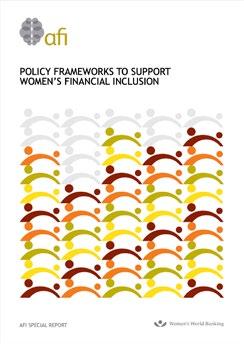
Policy Frameworks to Support Women's Financial Inclusion.
> View here
Policymakers and central bankers should consider developing and refining policies that address one or more of the following key areas:
> A greater focus on promoting the value proposition of women’s financial inclusion, with explicit policy objectives and quantitative targets, can lead to greater transparency and accountability for policymaking.
> Collecting financial sex-disaggregated data and conducting policy-related research leads to more informed policy development.
> Reforms to legal and regulatory frameworks can create more opportunities for innovation, which supports greater financial inclusion for women.
> The development of financial infrastructure is critical to sound policy implementation.
> Refining and strengthening financial consumer protection and market conduct regulation addresses issues of concern to women clients, balancing consumer protection with expanded outreach.
> Financial education and financial literacy programs for women present a critical investment in achieving sustainable women’s financial inclusion.
11 AFI and BTG. 2016. Policy Frameworks to Support Women's Financial Inclusion.
24 TOOLKIT ON GENDER INCLUSIVE POLICY DEVELOPMENT
> Collaboration with key stakeholders in the ecosystem is needed to tackle legislation and regulations that address the social norms constraining women’s financial inclusion that are often beyond the mandate of financial sector regulators and policymakers.
However, adopting policies relevant to the specific country’s context is critical. What has worked in one country might not work in another. Therefore, it is essential to understand the constraints women and men face in accessing financial services to design an effective financial inclusion strategy. A 4-step approach is recommended for implementing a gender constraints analysis.
1. Assess data availability: understand what information and data are available, particularly sex-disaggregated data, to support the development of realistic targets. Examples of financial inclusion strategy gender-related data include:
- Gender gap in access and usage dimensions (account ownership, credit, savings, payments, financial literacy, etc.).
2. Understand the financial inclusion barriers for GIF: desk research and data mining from the supplyand demand-side. Potential sources of information include:
Demand Side
- FinScope, Findex or other national-level financial inclusion-related datasets.
- Financial inclusion-focused publications by national, regional, and international organizations. Supply-side
- FSP data on credit disbursement, account ownership, etc.
- Information on market trends – gender-targeted products and services.
3. Seek to understand the broader legal and sociocultural constraints facing women’s economic participation and empowerment.
4. Commission studies: If gaps exist, commission studies similar to:
- Financial capability surveys
- FSPs surveys
- discussions with government agencies, development partners, the private sector, women’s community groups, and faith-based non-governmental organizations.
FINANCIAL INCLUSION STRATEGY PUBLICATIONS

Policy Model for National Financial Inclusion Strategy.
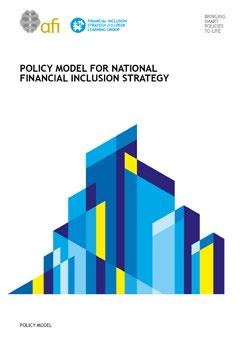
> View here
National Financial Inclusion Strategies: Current State of Practice (2022).
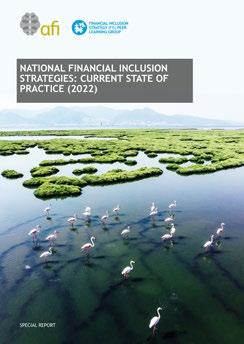
> View here
Integrating Gender and Women’s Financial Inclusion into National Strategies (V.2).
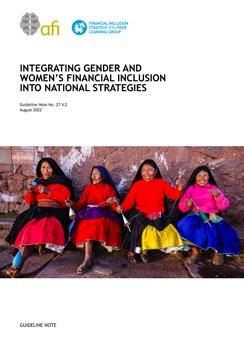
> View here
Integrating Digital Financial Services into a National Financial Inclusion Strategy.
> View here
25 TOOLKIT ON GENDER INCLUSIVE POLICY DEVELOPMENT
SME FINANCE
An important first step to formulating a women-owned MSME finance policy is establishing what a womenowned MSME means. The targeting of women-owned MSMEs requires understanding who and what they are. Women entrepreneurs are a broad and diverse group, including women with businesses of different sizes, management structures, ownership status, and above all, different needs. It is recommended to use international good practice models to develop a national definition. However, they may need to be adapted to the country’s context.
> For instance, the World Bank Group defines a woman-owned enterprise as one that meets the following criteria: (a) ≥ 51 percent owned by woman/women or (b) ≥ 20 percent owned by woman/women, and (i) has ≥ 1 woman as CEO/COO/
President/Vice President, and (ii) has ≥ 30 percent of the board of directors composed of women, where a board exists.
> In the United States, the Women’s Business Enterprise National Council validates a womanowned business if it is at least 51 percent owned, controlled, operated, and managed by a woman or women.
AFI members report that while some have put in place policies to promote access to finance for women-owned MSMEs, this is rarely made a priority at the institutional level.12 Additionally, most reported that access to data on women-owned MSMEs still needs to be improved.
12 AFI. 2017. Survey Report: SME Finance Policies for MSMEs Owned by Women and Women Entrepreneurs.
SAMPLIING
INSTRUMENT DESIGN FIELD IMPLEMENTATION
DATA ANALYSIS & REPORTING
> Identify scope: formal vs informal
> Sampling: best practice is to use business register if this includes information on gender of owner
> Power calculation should be used to ensure a minimum sample size of womenowned MSMEs necessary for statistical analysis
> Representative versus skewed: in most countries, men own the majority of MSMEs. It may thus be beneficial to skew the sample in favor of women to gain their perspective
> The instrument should consider the objectives of the study and be results-oriented
> Cover demand and supply-side issues for women MSMEs
> - FI Dimensions (Access, Usage, Quality)
> - Financing enablers
>- Developmental elements (market access, procurement, capacity building, cultural barrier)
> Gender sensitive instrument design techniques:
> - use gender sensitive language
> - Design questions so they are relevant to both women and men
Gender sensitive data collection techniques
> Having a genderbalanced team for conducting interviews
> Sensitizing enumerators to the importance of and rationale behind the gender assessment
> Consider women’s double burden of work and home responsibilities in timing of interviews
THE NORMS
> Objective: understand needs of women owned and men-owned MSMEs to allow for appropriate policies
> Analyze the data separately on women and men to understand patterns and trends
> Credit gap analysis to analyze market potential
> Statistical analysis such as cluster analysis can also be used to identify segments of W-SMEs
26 TOOLKIT ON GENDER INCLUSIVE POLICY DEVELOPMENT
FIGURE 9: HOW TO CONDUCT A WOMEN-OWNED MSME SURVEY
If sex-disaggregated data on the MSME segment is not collected, it is recommended that the institution commission a women-owned MSME survey. To do this, hiring a survey firm with experience in implementing gender-sensitive data collection techniques is recommended. These should be integrated throughout the design and implementation processes.
SME FINANCE PUBLICATIONS
Policy Model for MSME Finance.
> View here
Policy Framework on MSME Data Collection: A Guide for Gender Inclusive Finance. > View here

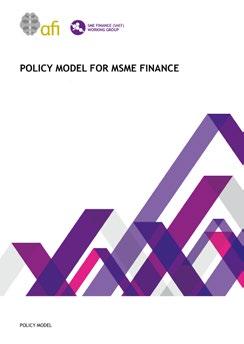
DIGITAL FINANCIAL SERVICES
Gender considerations should be integrated into the DFS strategy at the analytical and policy development stages. While undertaking DFS analysis, adopting a 360° approach is recommended, analyzing potential gender differences from the perspectives of the demand-side, channels, supply-side, and legislation and policy.
On the demand-side, it is recommended to assess social norms, access to and use of mobile phones, digital financial literacy, capability, and identify good practice DFS examples. . Assessing channels involves assessing gender gaps regarding banking agent typology, banking agent demography, and merchants.
On the supply-side, it is recommended to assess all FSPs in the country to understand any targeted gender products, their use of sex-disaggregated data analytics, and their offerings in terms of consumer protection. Analysis of legislation and policy entails a review of gender-related legislation that impacts women’s access to and use of DFS, processes, policies, use of sex-disaggregated data analytics, gender impact assessment, and gender resource budgeting and DFS infrastructure. Some of these fall outside the purview of financial sector regulators and policymakers and require close coordination and collaboration with other stakeholders in the ecosystem.
The outcome of such an analysis should be a comprehensive understanding of the needs of women, as well as the adaptation of existing relevant
TABLE 2: POTENTIAL DFS INDICATORS FOR GENDER INTEGRATION
ACCESS
USAGE
QUALITY
27 TOOLKIT ON GENDER INCLUSIVE POLICY DEVELOPMENT
> Proportion
men
access
> Proportion
> Account
> Proportion
of women and
with
to a mobile device
of women and men with an online/mobile account
registration in the user’s or a family member’s name
of women and men with access to agents/merchants
>
> Gender
> Gender
> Gender
Gender differences in the rate of usage of online/mobile account
differences in frequency of usage of online/mobile account
differences in types of transactions conducted via online/mobile account
differences in the volume of transactions via online/mobile account
> Gender
> Complaints
> Pricing
> Experience
differences in benefits from using online/mobile account
about using online/mobile accounts among women and men
differences among women and men
of abusive practices among women and men
FIGURE 10: POLICY FRAMEWORK FOR WOMEN’S FINANCIAL INCLUSION USING DIGITAL SERVICES
DIGITAL FINANCIAL SERVICES PUBLICATIONS
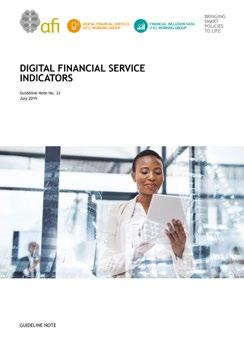
Guideline Note on DFS Indicators.
> View here
policies and regulations to meet those needs and the incorporation of gender considerations into the development of new policies and regulations. Gender should be considered and mainstreamed throughout the policy lifecycle to avoid unintended gender consequences.
Based on the assessment of gaps and needs, policy should be formulated along the four pillars of AFI’s GRID framework. As depicted in Figure 10 shows below, these include gender-sensitive policy and DFS legislation, regulation, infrastructure, and demand-side.
It is also recommended to integrate gender considerations into the M&E for DFS along each financial inclusion dimension, including access, usage, and quality. The institution should evaluate gender differences for each indicator collected to inform policymaking better. Table 2 provides examples of potential indicators.
FINANCIAL INCLUSION DATA
Sex-disaggregated data can be critical in closing the gender gap in financial inclusion. Gender statistics go beyond simply ex-post disaggregation of data and can include: (i) sex-disaggregated data (ii) targeted gender-specific indicators and (iii) indicators that implicitly reflect gender relations.
TABLE 3: POTENTIAL SOURCES OF SEX-DISAGGREGATED DATA
DEMAND-SIDE
FinScope, Findex, or other financial inclusion-related datasets.
Financial inclusion-focused publications by country, regional, and international organizations (MSME surveys, household surveys, etc., conducted by World Bank, International Finance Corporation, Asian Development Bank, etc.)
Primary data (surveys, Focus Group Discussions (FGDs), etc.)
SUPPLY-SIDE
FSP (banks, microfinance institutions, FinTechs) data on credit disbursement, account ownership, etc.
Secondary data (International Monetary Fund Financial Access Survey, MIX market data, etc.)
Information on market trends: gender-targeted products and services

OTHER RELEVANT PLAYERS
Central bank/financial regulators, finance enablers (credit bureaus, collateral registries, etc.)
Women’s advocacy groups, consumer groups, nongovernmental organizations
Retailers/merchants
28 TOOLKIT ON GENDER INCLUSIVE POLICY DEVELOPMENT
G R I D Demand Side Customer protection, sensitization, awareness and capability of women customers Regulation Gender-centric regulatory interventions Infrastructure Progressive infrastructure Gender-Sensitive Policy and DFS Legislation Gender-sensitive policy and DFS legislation
Most AFI members are already collecting sexdisaggregated data on either the supply-, demand-side, or both. As to those that do not currently have access to sex-disaggregated data, it is important to note that this can come from various sources and can be both quantitative and qualitative.

FSPs should be encouraged to collect sex- and agedisaggregated data on their clients because this presents valuable information necessary to develop a value proposition that meets the needs of the current client base. For this, it is critical to collect, analyze, and track indicators (approval, repayment, revenue growth, expansion into new markets) by gender. This would allow FSPs to build a better risk profile for their women customers and match supply accordingly.
FINANCIAL INCLUSION DATA PUBLICATIONS
Data quality is an important consideration in collecting, managing, and using sex-disaggregated data. Institutions should consider the pillars of high-quality data from a gender perspective. This includes assessing the validity, process adequacy, and analytics of all data collected and ensuring that gender is integrated correctly at each stage (Figure 11).
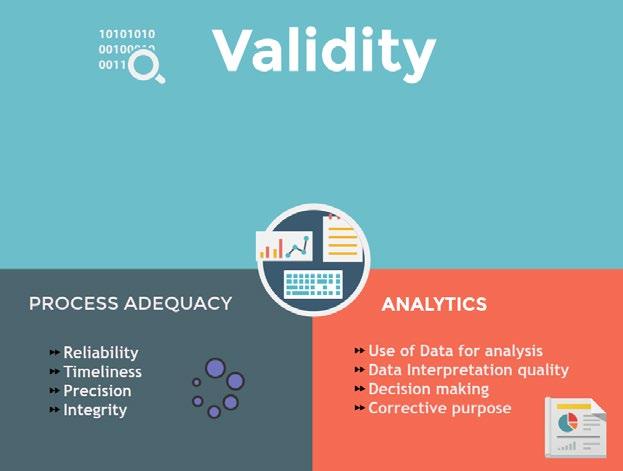
CONSUMER EMPOWERMENT AND MARKET CONDUCT
Integrating gender into Consumer Empowerment and Market Conduct (CEMC) policy should start by considering women’s unique position and needs across each of the key pillars of policy. Only five percent of AFI members surveyed considered they had gender-sensitive consumer protection mechanisms. As such, identifying the different consumer protection needs of women and men can be important for regulators to meet their consumer protection role. It is recommended that institutions use country-specific data as much as possible to understand gender differences in financial education, literacy and capabilities, trust, access to resources, vulnerability to abusive practices, access to appropriate complaint channels, and the formality and power dynamics of business activities.
Guideline Note on Sex-Disaggregated Data Report Templates.
> View here
Guideline Note 26: Sex-Disaggregated Data Toolkit.

> View here
Women are more likely to be more vulnerable than men because they have less opportunity to complete their education, the prevalence of illiteracy, and a lack of access to timely information. Based on an understanding of gender aspects, appropriate policies can be developed to address the key issues.
FIGURE 11: THREE PILLARS OF QUALITY SEX DISAGGREGAGED DATA
Key Questions:
What percentage of data is disaggregated by sex?
Do indicators consider potential differences between de facto and de jure ownership and access
Do indicator definitions include descriptions on data disaggregation by sex?
Are there guidelines for handling gender sensitive data?
Do staff analyze data and develop charts, graphs, etc. disaggregated by sex?
29 TOOLKIT ON GENDER INCLUSIVE POLICY DEVELOPMENT
quality gender data to support policy initiatives? To answer this question the DQR should carry out a comprehensive analysis of each of the indicators.
Is the organization getting
> Consumer education: Women often have lower levels of general education, literacy, financial education, financial literacy, and capabilities. As women are commonly regarded as resource managers, targeted consumer education can be developed to address the identified gender gap and, more importantly, improve their management of personal and household finances. Understanding how to effectively manage their finances will help them select and gain better access to products and services tailored to their specific needs.


> Effective supervision and enforcement: This should be examined both from the institution’s perspective and the fostering of an ecosystem in which strong consumer activism helps drive efficiency in the financial sector. It is important to consider whether there are gender differences in terms of CEMC initiatives. Effective enforcement of consumer laws is necessary to protect consumers from unfair, fraudulent, and deceptive practices, of which women are frequent victims.
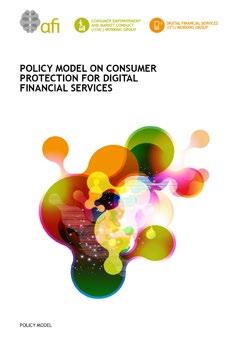
30 TOOLKIT ON GENDER INCLUSIVE POLICY DEVELOPMENT
include:
Examples of critical assessment of CEMC policy from a gender perspective
Policy Model on Consumer Protection for Digital Financial Services. > View here National Financial Education Strategies Toolkit. > View here Financial Education Programs Monitoring & Evaluation Toolkit. > View here CONSUMER EMPOWERMENT AND MARKET CONDUCT PUBLICATIONS FIGURE 12: THREE PILLARS OF QUALITY SEX DISAGGREGAGED DATA CONSUMER EDUCATION EFFECTIVE SUPERVISION & ENFORCEMENT RELEVANT GENDER CONSIDERATIONS > Low level of financial education, literacy and capabilities > Lack of trust > Unequal access to resources > Vulnerability to abusive practices > Need for adequate gender-sensitive complaint channels > Informal nature of women’s activities > Gender-related power dynamics FAIR TREATMENT OF CONSUMERS RESPONSIBLE BUSINESS CONDUCT SUSTAINED PUBLIC CONFIDENCE ENHANCED INFORMED PARTICIPATION KEY PILLARS IN POLICY FORMULATION
> Fair treatment of consumers: In addition to ensuring fair treatment, institutions should critically assess whether men and women receive the same level of treatment. Potential issues might include gender differences in levels of financial literacy and the ability to distinguish predatory practices.
> Sustained public confidence: In some countries, women are less likely to use the formal financial system due to a lack of self-efficacy, trust, and confidence in the financial institutions. Gender differences in trust and confidence in the formal financial system would need to be overcome to foster women's greater usage of financial products and services in the long run.
GLOBAL STANDARDS PROPORTIONALITY
If proportionality considerations are sufficiently prioritized, implementing global standards for financial integrity and stability may positively affect the financial inclusion of women and other disadvantaged groups. For example, in cases where account opening requirements stipulate types of documentation that are less commonly held by women, especially in lowincome communities and rural areas, or when women entrepreneurs are unable to access credit from financial institutions due to a lack of credit history, collateral, discrimination, or risk perceptions. Incorporating gender considerations into the implementation of global standards is crucial and can help mitigate such unintended outcomes. Institutions should thus consider ways to integrate gender considerations across the four dimensions shown in Figure 13.
TRANSACTION COSTS
These can be monetary or non-monetary costs related to compliance with regulations (opportunity cost, time spent traveling and waiting). Institutions should consider the differential impacts these might have and ensure they are proportional to the benefit level for women and men.
INFRASTRUCTURE REQUIREMENTS
Policy innovations intended to improve financial inclusion often come with specific infrastructure requirements (internet, electricity, transport, etc.) Access to infrastructure is critical. Gender differences in access to infrastructure should be considered when developing and applying standards.
PERSONAL IDENTIFICATION REQUIREMENTS
A range of evidence suggests that lack of identification to meet international KYC requirements for anti-money laundering/combating the financing of terrorism is one of the main barriers to women’s financial inclusion.13 In jurisdictions where women face more challenges in obtaining a national ID card, they are, on average, less likely to borrow from a formal financial institution. Consider including alternative forms of identification on the list of acceptable identification documents, such as a letter from the village chief.
Given gender differences in ownership of identification documents, consider the value of collecting specific data points from individuals versus the cost of women’s financial inclusion. Finally, consider the potential of national digital ID and e-KYC to enhance women's financial inclusion, provided that gender inclusion is built into the design of such initiatives (ensuring full enrollment of women in the national digital ID databases).
13
Inclusion. 2019. KYC Innovations, Financial Inclusion and Integrity. Guideline Note 32. Available at: https://www.afiglobal.org/wp-content/uploads/publications/2019-03/KYC-InnovationsFinancial-Inclusion-Integrity-Selected-AFI-Member-Countries_0.pdf
31 TOOLKIT ON GENDER INCLUSIVE POLICY DEVELOPMENT
FIGURE 13: FOUR DIMENSIONS TO CONSIDER WHEN INTEGRATING GENDER CONSIDERATIONS INTO A POLICY FOR FINANCIAL INCLUSION TRANSACTION COSTS INFRASTRUCTURE REQUIREMENTS PERSONAL IDENTIFICATION REQUIREMENTS ALIGNMENT WITH GENDER NORMS
Alliance for Financial
ALIGNMENT WITH GENDER NORMS
In applying standards, it is critical to keep in mind gender norms that may hamper the ability of women to participate in the formal financial system. For example, KYC requirements may require an individual to visit a bank branch in person. Still, because of cultural norms, women remain reluctant or even prohibited from speaking with men alone.
If bank officials are mainly men, this can hinder women from accessing financial services. These socio-cultural norms may not appear in the data and need to be rooted in an in-depth understanding of the cultural context. Institutions should incorporate collaboration with women’s community groups and CSOs to ensure their perspectives are considered.
Institutions should consider the following elements when designing standards for Anti-Money Laundering and Countering the Financing of Terrorism (Figure 14).
FIGURE 14: THREE ELEMENTS TO CONSIDER IN THE DESIGN OF ANTI-MONEY LAUNDERING AND COUNTERING THE FINANCING OF TERRORISM STANDARDS
INCLUDE GENDER IN NATIONAL RISK ASSESSMENT
Elements such as gender differences in access and usage of financial services, associated barriers and enablers; gender differences in types of financial services and delivery channels used; gender differences in criminal risk.
CUSTOMER VERIFICATION
Women can be disproportionately affected by a one-size-fits-all approach to customer verification since they are less able to fulfil documentation requirements.
SIMPLIFIED OR TIERED KYC
> Products tailored for women with lower identification requirements can be particularly beneficial for closing the gender gap while also minimizing ML/TF risks
> Research suggests that biometric identity cards have been a driving factor in increasing account ownership among women.
GLOBAL STANDARDS PROPORTIONALITY PUBLICATIONS
Guideline Note on Gender Considerations in Balancing Financial Inclusion and AML/CFT.
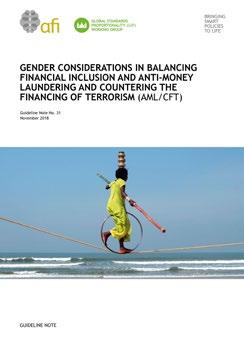
> View here
Inclusive Financial Integrity: A Toolkit for Policymakers.
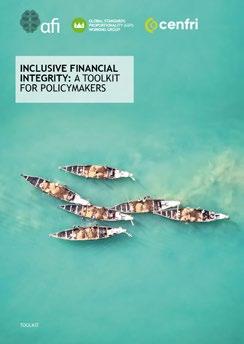
> View here
Policy Model for Digital Identity and Electronic Know Your Customer (e-KYC).
> View here
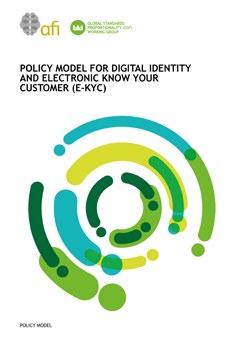
32 TOOLKIT ON GENDER INCLUSIVE POLICY DEVELOPMENT
INCLUSIVE GREEN FINANCE
Policy formulation on gender-inclusive green finance should include three key elements:
> Sex-disaggregated data: Climate change disproportionately impacts women. Socio-cultural norms regarding gender roles limit female-led MSMEs’ access to sectors and resources, which makes them more exposed to climate risk. The collection of sex-disaggregated green finance data will allow an understanding of these sectors and where activities need to be targeted.
> Adapt and innovate based on gender-unequal impacts of climate change: Adaptation-oriented financial services for women-owned MSMEs enable women to better cope with climate change and gain access to new markets. Paying attention to smallscale and informal sectors where women are typically concentrated is critical. Examples of potential adaption-oriented proposals include green credit quotas for women-owned MSMEs, green credit guarantee schemes, gender sensitization training for financial institutions and gender criteria in performance objectives.
> Consumer education: It is critical to ensure that women can take advantage of new opportunities. One approach could be through collaboration with local women’s groups and organizations.
AFI’s 4Ps Framework can be used to center women in the process.14 Provisions are policies that help a government ensure that financial services are provided to qualified beneficiaries, including girls and women.
Promotion includes policies that allow the government to incentivize the private sector to offer financial services to qualified beneficiaries. A gender perspective would involve including women and girls as beneficiaries and tailoring financial services to meet the needs of women and girls. Prevention policies aim to avoid undesirable outcomes rather than address them after the fact. Centering gender in these policies might include raising awareness in a gender-inclusive manner. Protection includes policies that reduce financial risk by “socializing” potential losses through insurance or social payments or by giving exceptional access to one’s assets. In this context, ensuring women have equal access to insurance, social payments, and assets would be beneficial.
INCLUSIVE GREEN FINANCE PUBLICATIONS
Special Report on Towards an Inclusive Green Future: An Analysis of the Intersection Between Inclusive Green Finance and Gender Inclusive Finance.
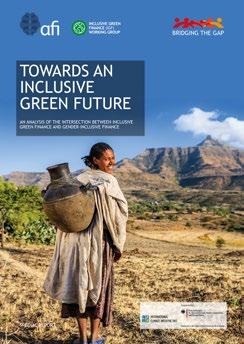
> View here
PROVISION
Ensure qualified beneficiaries include girls and women and that selection processes favour them; and that policy implementation takes them into account, that policies are developed in consultation with women and girls.
PROMOTION
Ensure any private sector schemes take into account girls and women; that government policies are developed in consultation with women; endure financial services offered include ones tailored to women's needs and realities.
14 AFI. 2019. Inclusive Green Finance: A Survey of the Policy Landscape.
PREVENTION
Ensure socialization and awareness raising includes women, with targeted schemes to ensure this; and that women have equal access to insurance and social payments; and equal access to asset.
PROTECTION
Through consultation with communities and though expert TAensure a do no harm; intersectional and gender sensitive lens is applied to all policy making.
33 TOOLKIT ON GENDER INCLUSIVE POLICY DEVELOPMENT
FIGURE 15: CENTERING WOMEN IN 4PS FRAMEWORK FOR INCLUSIVE GREEN FINANCE
CENTER AND PRIVILEGE WOMEN AND GIRLS VOICES (OVERLAY OF 4 QUADRANTS WITHIN THIS CIRCLE)
ADDITIONAL CONSIDERATIONS AND WAY FORWARD OVERVIEW OF THE PROPOSED PROCESS
FIGURE 16: THE THREE PHASES OF POLICY DEVELOPMENT, IMPLEMENTATION AND MONITORING AND EVALUATION
KEY QUESTIONS
Is there a gender ambassador or working group that can lead the GIF process?
Is the role of the structure clear?
Is there common understanding of gender concepts and objectives?
Is there commitment or resistance?
Are there strategies to overcome resistance?
Do current policies around financial inclusion consider gender?
Are there gender biased policies that should be changed?
Are there gaps in policy that can be filled?
What are the gender gaps in terms of financial access, usage and quality?
What are the major challenges for women that could be addressed through policy?
SETTING PRIORITIES AND TARGETS
What is the vision of the proposed strategy?
What are the objectives?
What are the expected outcomes?
TRAINING OF TRAINERS APPROACH
As policymakers work toward closing the gender gap in financial inclusion, there is a need to take an overarching gender lens approach. There are many opportunities to integrate a gender-sensitive approach to financial inclusion throughout each stage of the policy development process. Capacity-building on gender equality will be critical to ensuring that strategies put forward have the intended impact.
To ensure sustainability, we recommend holding a Training of Trainers (ToT) event to ensure an adequate understanding of gender issues and the use of this toolkit. The ToT model engages master trainers in coaching new trainers. Trainees do not need to have previous experience in gender inclusive policy development or implementation, but it is recommended that the trainees express an interest in the objective.
FIGURE 17: THE TRAINING THE TRAINERS CASCADE PROCESS
34 TOOLKIT ON GENDER INCLUSIVE POLICY DEVELOPMENT
COORDINATING STRUCTURES GENDER CAPACITY BUILDING GENDER FOCUSED STOCK-TAKING
PHASE 1: PRE-FORMULATION PHASE 2: FORMULATION ESTABLISH
DIAGNOSTIC STUDIES
PHASE 1: IMPLEMENTATION AND MEASUREMENT
DEFINING THEORY OF CHANGE M&E FRAMEWORK GENDER ACTION PLAN GENDER RESPONSIVE BUDGETING
What activities ate geared toward gender equality objectives?
How are they expected to lead to expected outcomes?
What risks are there to achieving them?
Are gender indicators incorporated into the M&E framework?
Are there plans for collecting, managing and analyzing sexdisaggregate data?
Is there a gender equality plan in place? Does it have the necessary resources?
Does the plan include gender sensitive communications?
Are gender equality objectives included in the budgetary allocation?
Does the financial tracking system include provisions for tracking resource allocation to gender equity?
GENDER IMPACT ASSESSMENT
Does the strategy have an impact on participation, access to resources, or gender based social norms and values?
If yes, is this impact positive or negative?
It is recommended that institutions’ management units and staff receive the training necessary to support people working in their technical areas. A ToT workshop can build a pool of competent instructors who can teach others the material. Instead of having just one trainer who teaches a course for a long time, multiple trainers teach the same course simultaneously in the ToT model. This means a new participant typically gets to observe an experienced trainer teach, complete the exercises developed as part of the training course, and then practice teaching segments to other participants.
Taking an institutional approach, gender ambassadors can be trained to train other staff. We recommend that all staff receive gender-sensitive training to become familiar with the needs of men and women and adopt the most appropriate way to meet those needs. A ToT approach can be used to implement this
series of training. This will allow them to not only monitor the progress of the institution in implementing gender initiatives but also provide follow-up training and support for other stakeholders in their country on gender issues and the practical use of the toolkit. This ToTs approach would create a sufficiently large pool of experts who understand the issues and are genuinely interested in the topic to be able to transfer knowledge more broadly in the countries and ensure that core messages are distributed to a wider audience.
A certification program could also be implemented so that participants can earn a document from a reputable institution demonstrating their competence as a Trainer of Trainers in gender and financial services.
35 TOOLKIT ON GENDER INCLUSIVE POLICY DEVELOPMENT
ABBREVIATIONS
BRB Banque de la République du Burundi
CEMC Consumer Empowerment and Market Conduct
CNBS Comisión Nacional de Bancos y Seguros
CSO civil society organizations
DFS digital financial services
FSP financial service provider
GAP gender action plan
GIF gender inclusive finance
KYC know-your-customer
M&E monitoring and evaluation
NFIS National Financial Inclusion Strategy
ToT Training of Trainers
REFERENCES
AFI and BTG. 2016. Policy Frameworks to Support Women's Financial Inclusion.
AFI. 2013. Financial Inclusion Data Tracking and Measurement. Demand-Side Surveys to Inform Policymaking.
AFI. 2017. Survey Report: SME Finance Policies for MSMEs Owned by Women and Women Entrepreneurs.
AFI. 2019. AFI hails first Gender Ambassadors for supporting diversity.
AFI. 2019. Communicating Women’s Financial Inclusion.
AFI. 2019. Inclusive Green Finance: A Survey of the Policy Landscape.
AFI. 2020. Guideline Note on Sex-Disaggregated Data Report Templates.
AFI. AFI data portal.
European Institute for Gender Equality. Gender evaluation.
ILO. 2012. A manual for gender audit facilitators: The ILO participatory gender audit methodology (2nd Edition).
Japan International Cooperation Agency. 2017. Country Gender Profile Democratic Republic of the Congo Final Report.
Masciandaro, et al. 2016. Gender Diversity and Monetary Policy. SUERF Policy Note Issue No 4, February 2016.
OECD. Evaluation Criteria.
OECD/DAC Network on Development Evaluation. 2019. OECD-DAC Principles for Evaluation of Development Assistance.
OECD/DAC. 2002. Glossary of Key Terms in Evaluation and Results-Based Management.
Oxfam. 2014. Novib Women Empowerment Mainstreaming and Networking (WEMAN). Gender Action Learning System: Practical Guide for Transforming Gender and Unequal Power Relations in Value Chains.
The Kingdom of Cambodia. 2019. National Financial Inclusion Strategy 2019-2025.
36 TOOLKIT ON GENDER INCLUSIVE POLICY DEVELOPMENT
CASE STUDY SOURCES
Case study 1 Source: AFI Member interview. Bank of Zambia, 2021
Case study 2 Source: AFI. 2019. INTEGRATING GENDER AND WOMEN’S FINANCIAL INCLUSION INTO THE CENTRAL BANK OF EGYPT’S (CBE) FRAMEWORK
Case study 3 Source: Tanzania National Council for Financial Inclusion,
Case study 3 Source: National Financial Inclusion Framework (2014 – 2016) and the National Financial Inclusion Framework 2018 - 2022
Case study 4 Source: AFI. 2017. WOMEN’S FINANCIAL INCLUSION IN THE SOLOMON ISLANDS - A SIMPLE OPPORTUNITY CAN MAKE A DIFFERENCE - Case Study No. 7 August 2017
Case study 5 Source: AFI member interview, Reserve Bank of Zimbabwe, 2021.
Case study 6 Source: Banque de la République du Burundi website
Case study 7 Source: FIJI - National Financial Inclusion Strategy 2022-2030
Case study 8 Source: The Kingdom of Camboodia. National Financial Inclusion Strategy 1919 - 2025
Case study 9 Source: AFI Gender Inclusive Finance Unit interview, 2021
Case study 10 Source: The Kingdom of Cambodia. 2019. National Financial Inclusion Strategy 2019-2025
Case study 11 Source: AFI Gender Inclusive Finance Unit interview, 2021
Case study 12 Source: AFI Gender Inclusive Finance Unit interview, 2021
RESOURCES FOR FURTHER CONSIDERATION
AFI POLICY DOCUMENTS
AFI. 2019. AFI Core Set of Financial Inclusion Indicators.
AFI. 2019. Policy framework for women's financial inclusion using digital financial services.
AFI. 2019. Policy Model For E-Money.
AFI. 2020. Policy Model for National Financial Inclusion Strategy.
AFI. 2020. Policy Model on Consumer Protection for Digital Financial Services.
AFI. 2021. Policy Model for MSME Finance.
AFI. 2021. Policy Model for Digital Identity and Electronic Know Your Customer (e-KYC).
ORGANIZATIONAL GENDER MAINSTREAMING
AFI. 2018. Gender Diversity within AFI Member Institutions.
ILO. 2012. A manual for gender audit facilitators: The ILO participatory gender audit methodology (2nd Edition).
EIGE. 2016. Institutional Transformation: Gender Mainstreaming Toolkit.
EIGE. 2016. Gender Equality Training: Gender Mainstreaming Toolkit.
GENDER-AWARE POLICYMAKING
AFI and BTG. 2016. Policy Frameworks to Support Women's Financial Inclusion.
AFI. 2022. Guideline Note 27: Integrating Gender and Women’s Financial Inclusion into National Strategies (V.2).
AFI. 2017. Survey Report: SME Finance Policies for MSMEs Owned by Women and Women Entrepreneurs.
AFI. 2019. Denarau Action Plan: The AFI Network Commitment to Gender and Women's Financial Inclusion.
AFI. 2020. Why the economic response to COVID-19 needs to be financially inclusive and gender sensitive.
37 TOOLKIT ON GENDER INCLUSIVE POLICY DEVELOPMENT
AFI. 2019. Denarau Action Plan: The AFI Network Commitment to Gender and Women's Financial Inclusion.
AFI. 2020. Why the economic response to COVID-19 needs to be financially inclusive and gender sensitive.
CONDUCTING GENDER-SENSITIVE DIAGNOSTIC STUDIES
AFI. 2013. Financial Inclusion Data Tracking and Measurement Demand-Side Surveys to Inform Policymaking.
AFI. 2017. AFI Guideline Note 25: Leveraging SexDisaggregated Data.
AFI. 2017. AFI Guideline Note 26: Sex-Disaggregated Data Toolkit.
AFI. Data Portal.
GENDER-SENSITIVE COMMUNICATIONS STRATEGIES
AFI. 2019. Communicating Women's Financial Inclusion.
GIZ. 2021. Women’s Financial Inclusion Toolkit, Paving the way for women's economic empowerment.
GENDER-RESPONSIVE BUDGETING
Budlender, D., & Hewitt, G. 2003. Engendering Budgets: A Practitioners Guide to Understanding and Implementing Gender-Responsive Budgets. Commonwealth Secretariat.
United Nations Population Fund and United Nations Development Fund for Women. 2006. Gender Responsive Budgeting in Practice: A Training Manual.
GENDER-SENSITIVE EVALUATION
EIGE. 2017. Gender Impact Assessment Gender Mainstreaming Toolkit.
WECF International Women 2030. 2018. The gender impact assessment and monitoring tool.
Government of Canada, Impact Assessment Agency. Gender-Based Analysis Plus in Impact Assessment Factsheet.
ANNEXES
ANNEX 1. CONCEPT NOTE
CONCEPT NOTE: BACKGROUND
> Provide a light overview of the institution (a few lines at most)
> The background: why you are doing the project, what is the rationale, and what is the progress you have made in the topic area to date
> Include scarce relevant data without going into too much detail.
(Total 100-150 words)
OVERVIEW
> This is the problem statement that you are trying to solve
> Set the scene for the project and describe the main factors driving it forward
> Say why this matter needs to be tackled now and what you are hoping to achieve
> Say what is the overall goal you are looking to reach.
(Total 400-500 words)
OBJECTIVE AND KEY ACTIVITIES
> Say what is the key objective of this project
> Say what actions will be needed to meet this objective
> Say what key activities will be included?(Total 100-150 words)
DELIVERABLES AND TIMELINE Tasks
List the key tasks needed (multiple lines can be added)
Timeline
List the dates by which key project tasks need to be completed by
38 TOOLKIT ON GENDER INCLUSIVE POLICY DEVELOPMENT
ANNEX 2. AFI’S GENDER-INCLUSIVE FINANCE THEORY OF CHANGE
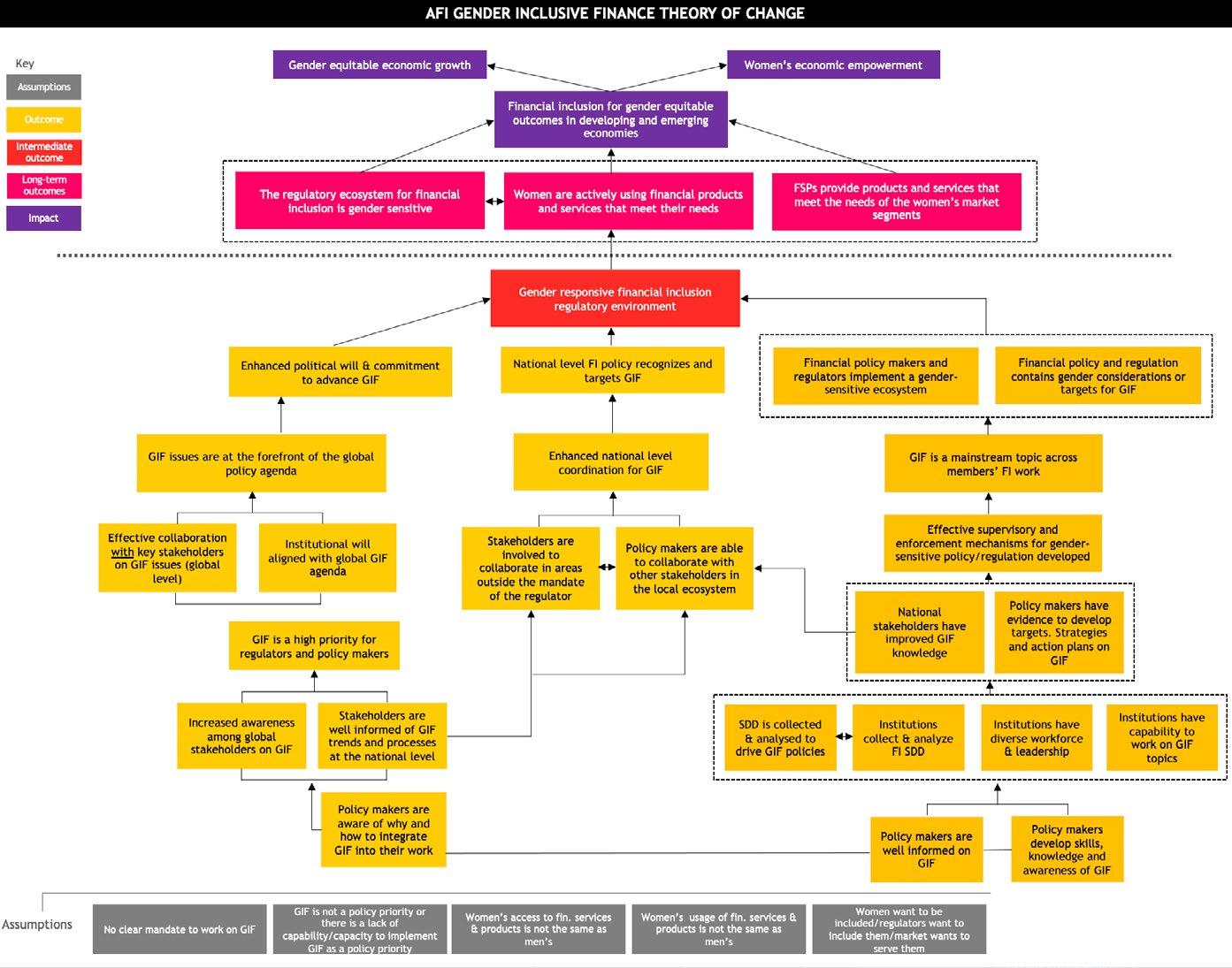
39 TOOLKIT ON GENDER INCLUSIVE POLICY DEVELOPMENT
ANNEX 3. THE SMART TEST TOOL
TESTING CRITERIA KEY QUESTIONS TO ASK
SPECIFIC Is this plan clear, straightforward, and specific? A clear and specific target attracts greater buy-in and mobilizes greater stakeholder support.
MEASURABLE Can the plan progress be tracked using relevant indicators? A measurable target compels the use of reliable indicators for effective progress monitoring.
ATTAINABLE Does your institution have the appropriate mandate to deliver this plan? Or is this a potential joint commitment with another agency from your country? Targets need to strike a balance between being ambitious/aspirational and realistic.
RELEVANT Is this plan in line with your country’s overall women’s financial inclusion strategy? A target that is not aligned with your institution’s or country’s strategic priorities cannot be considered sound.
TIME-BOUND Does this plan have an expected delivery date? A target without a deadline does not send a strong message that this target will be achieved.
40 TOOLKIT ON GENDER INCLUSIVE POLICY DEVELOPMENT
ANNEX 4. LIST OF AFI MEMBERS INTERVIEWED
MEMBER INSTITUTION PARTICIPANT
Banco Central de São Tomé e Príncipe Esperança Costa Banco de Moçambique Arlindo Francisco Lombe, Nadimo Carimo
Banco Nacional de Angola Teresa Evaristo Pascoal Bangko Sentral ng Pilipinas Jenny Romero Asistin
Bank Al-Maghrib Ibtissam El Anzaoui
Bank of Ghana Rose Obeng-Dokyi, Settor Amediku
Bank of Papua New Guinea George Awap
Bank of Russia Nadezhda Prasolova
Bank of Zambia Brenda Mwanza
Banque Centrale De La Republique De Guinee Mohamed Lamine CONTE
Banque Centrale des Estats de l’Afrique de Ouest DABOU Niffone Jacqueline Banque de la République d’Haiti Ann Valery Victor, Christine Toussaint, Nathalie Lamothe
Banque de la République du Burundi BIZIMANA Jocelyn Diane
Central Bank of Jordan Nadia Alloh, Saja Farhan
Central Bank of Liberia Fonsia Mohammed Donzo
Central Bank of Paraguay Christian Tondo
Central Bank of Samoa Lanna Lome-Ieremia
Central Bank of Solomon Islands Linda Folia
Central Bank of the Gambia Fatou Deen Touray
Comisión Nacional de Bancos y Seguros, Honduras Ligia Marcela Herrera
Da Afghanistan Bank Mir Ahmad Shekib Mir
Direction Générale du Trésor/Ministère de l'Economie et des Finances, Madagascar Nivoarizay Liva Razafindrakoto
First Atlantic Bank Mary Anderson
Maldives Monetary Authority Aishath Asna Hamdi
Ministère de l'Economie et des Finances Suame Tehia Felix Ministère des Finances, Madagascar
Rakotoarimanana Hery Njaka
National Bank of Tajikistan Shakhnozakhon Mukhamadieva
Palestine Monetary Authority Mohannd Salous
Reserve Bank of Fiji Joseph Esala Masitabua Royal Monetary Authority of Bhutan Pemadorji
Superintendente de Economía Popular y Solidaria, Ecuador Catalina Pazos
Zenith Bank (Ghana) Limited Samuel Quansah
41 TOOLKIT ON GENDER INCLUSIVE POLICY DEVELOPMENT
Alliance for Financial Inclusion
AFI, Sasana Kijang, 2, Jalan Dato’ Onn, 50480 Kuala Lumpur, Malaysia t +60 3 2776 9000 e info@afi-global.org www.afi-global.org
Alliance for Financial Inclusion AFI.History @NewsAFI @afinetwork






























